33 min read • Strategy
Time to renew your pilot’s license?
Five technologies board members and CEOs must keep on their radar screens


Executive Summary
Just as the pilot must refresh and renew capabilities continuously to be fit for flight, so must the business leader. A decade of challenging business conditions marked by geopolitical and macroeconomic headwinds has led to the promise of disruptive and exponential technologies.
A clear helicopter view, more than ever before, is critical in separating the winners from the less successful. Board members and CEOs need a better understanding of disruptive and exponential technologies and their impact on business.
In this Report, we present five key technologies and explain why they are essential to be on the radar for every board member and CEO, and how they should use them to their advantage.
1
TECHNOLOGY: THE ENABLER OF BUSINESS ACTIVITY
Meaningful businesses operate and thrive in a fundamental ecosystem consisting of five factors:[1] humans, machines, capital, energy, and rules. Technology has always played a crucial role in shaping this ecosystem to improve performance and to overcome challenges, and this remains true today (see Figure 1):
-
Humans recently have been challenged by the COVID-19 pandemic, disrupting societies and economies on a global scale. However, the rapid development and release of vaccines based on new mRNA technology, as well as processes to bring them to commercial use, thwarted an even more catastrophic scenario.
-
Machines (computers) are pushing up against physical limits on the number of transistors that can fit on a chip, thereby struggling to deliver on Moore’s law (roughly a doubling every two years) and associated performance increase. Major advancements in artificial intelligence (AI) and quantum computing, however, open up a potential step change in productivity.
-
Capital and markets play a key role in allocating resources between sectors and over time. Adequately priced and efficiently distributed and deployed, capital acts as a powerful lubricant in the ecosystem, and we have relied on this to support the last decade of growth. However, the current situation, characterized by a lack of capital and underinvestments, threatens a discontinuity in our ecosystem performance.
-
Energy — cheap, abundant, and clean — is a must-have for sustainable ecosystem growth. Today, this is not the case, as 80% of global prime energy still comes from climate-degrading fossil fuels.[2] Energy prices are soaring and intermittent renewable sources do not generate enough when needed. Advanced nuclear power, however, can provide the stable, safe, low-carbon energy source that the world desperately needs.
-
Rules and regulations are prerequisites for well-functioning markets. Current geopolitical trends characterized by a breakdown of trust between countries and trade blocs is hampering free trade, leading to a break up and regionalization of yesterday’s global supply chains. Blockchain technology, with features such as cryptographic trust and transparency, can contribute to making supply chains more efficient, resilient, and secure.

All in all, we believe that the 2020s will be very different from the 2010s, requiring businesses to assess and adapt their playbooks.
Technology can help us address, mitigate, and overcome challenges, but only if they are understood and harnessed by key decision makers in business.
2
DISRUPTIVE, EXPONENTIAL & CONVERGENT TECHNOLOGIES
Never before have there been so many innovation platforms in concurrent development, reinforcing each other and creating new and previously unthinkable use cases. These platforms span a number of disruptive, sometimes exponential, and often convergent technologies.
These technologies are significantly altering the way that consumers, industries, and businesses operate. At the same time, the pace at which they are evolving in terms of performance is in many cases increasing on an exponential scale, with a significant impact on business and society as a whole.
Convergence across technologies will amplify their potential. For example, the convergence of robotics, battery technologies, and AI is likely to fundamentally alter the cost structure of transportation. And the convergence of next-generation DNA sequencing, AI, and gene therapy will enable personalized medicine and thus has the potential to create a new golden age for healthcare. A third example is the convergence of application programming interfaces (APIs), social platforms, and blockchain technology, with the potential to integrate business and consumer marketplaces in ways that were not previously possible.
These transformative technologies are approaching important tipping points as performance increases and costs decrease, leading to increased demand across industry sectors. In fact, Arthur D. Little (ADL) analysis shows that market capitalization for the above-mentioned technologies combined has already cleared the US trillion-dollar mark and is forecasted to grow 15x by 2030.
The corporate competence deficit
Sadly, it seems that many top management teams and boards of directors don’t have the capabilities and track records required to harness and leverage disruptive technologies.
According to a Massachusetts Institute of Technology (MIT) study[3] of about 2,000 companies published in March 2021, only 7% were led by technologically competent teams; that is, a team where over half of the members are tech savvy, with a firm understanding of how emerging tech will shape their company’s success. Unsurprisingly, those companies outperformed the rest by 48% in terms of revenue growth and market valuation. We believe this is because they can identify the benefits of new technologies and make investments in developing their capabilities and then outcompeting with new products, services, and business plans.
Company boards aren’t that different either; an earlier MIT study of around 3,000 companies with over US $1 billion in annual revenues showed that 76% of boards weren’t tech savvy — be it in terms of directors’ backgrounds, the number with tech experience, or the manner in which boards interacted with executives on technology-related issues.[4] Interestingly, companies with three or more tech savvy directors on their boards reported 17% higher profit margins and 38% higher revenue growth than those with two or fewer directors.
We at ADL believe that bridging the corporate competence deficit with regards to disruptive technologies should arguably be one of the most pressing issues for every board and CEO across all industry sectors.
3
FIVE KEY TECHNOLOGIES TO GET ON YOUR RADAR
In helping our clients across all industries create value by linking people, strategy, and technology, we have the knowledge and experience from working with all the innovation platforms and disruptive technologies mentioned in Chapter 2. In this Report, we have selected five technologies that will play pivotal roles in shaping the future of business and society:
-
Small modular reactors
-
Artificial intelligence
-
Blockchain technology
-
Quantum computing
-
Cell and gene therapy
Although we acknowledge the difference between AI as a “general-purpose” technology and cell and gene therapy as more “industry- specific,” we firmly believe that all five have an impact ranging far beyond any individual industry sector, and as such are of great importance to most, if not all, business leaders.
For each of the five technologies, our objective is to provide answers to the following questions:
-
What is it?
-
Why is it important?
-
What are the use cases?
-
What are the success stories?
In aggregate, according to industry analyses, the market size of these five technologies is expected to grow exponentially (~20x) from ~$100 billion in 2021 to ~$2.2 trillion in 2030, corresponding to 40% CAGR (see Figure 2). By 2029, it will surpass today’s size of the global passenger cars market!
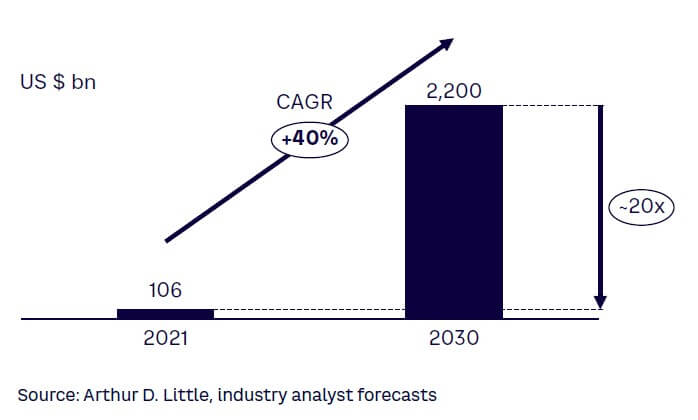
Small modular reactors
Following the first discovery of nuclear fission in 1938, it took until 1951 for electricity first to be generated from nuclear power. Following fast growth between the 1970s and late 1980s, however, nuclear energy has failed to live up to its promise.
Despite being a low-carbon energy source, accidents such as Chernobyl and Fukushima have hindered the positive public perception of nuclear energy. In addition, regulatory uncertainty, long development times, and high investment cost with frequent cost overruns of new build projects have made countries and utility companies hesitant to further initiatives in nuclear fission. Consequently, the amount of the world’s electricity production from nuclear sources fell from 17.5% in 1996 to 10.1% in 2020.[5]
Now, governments have committed to ambitious climate-change targets that have been giving the technology a second glance. In January 2022, the European Union added nuclear power to a list of projects eligible for green finance. Russia’s invasion of Ukraine and Europe’s dependency on Russian oil and gas have sent fossil fuel prices soaring and put energy security at the top of Europe’s political agenda.
Nuclear energy is experiencing a resurgence as more countries worldwide either extend the life span of existing reactors and/or build new ones. For example, Japan shut down its fleet of 50 remaining reactors following the Fukushima accident in 2011. By now, however, Japan has already reopened 17 reactors, while 16 remain in suspended operation. Japan continues to build two new ones, albeit with slow progress. In the US, three nuclear power plants received a positive signal to extend their lifetimes to 80 years, subject to a full environment review. Germany finally seems to be backing away from its entrenched, and in hindsight misguided “Energiewende,” and a public discussion about prolonging the life span of the country’s remaining operational nuclear capacity has started. Countries like China, India, and the UK continue with their plans to revitalize and grow their nuclear fleets. Nuclear newcomers like the United Arab Emirates and the Kingdom of Saudi Arabia, as well as European countries like Hungary and the Czech Republic, are also proceeding with their nuclear energy plans.
To bring the global share of nuclear energy to a level where it moves the needle as a low carbon, reliable alternative given the current state of the technology nevertheless requires far too great an investment over a too long time frame. The nuclear industry may have the answer: A new generation of small modular reactors (SMRs) that are designed to be cheaper, quicker, and less financially risky to build.
In contrast to current nuclear reactors that require large safety zones, SMRs can be placed where they are most needed. Energy production is not the main issue; instead, the bottleneck emerges when trying to both transport and store the energy efficiently. Being able to strategically place these SMRs where the need is offers a solution to a problem that traditional nuclear plants have been unable to solve. Additionally, series production, standardization, and less complicated systems result in a significant reduction of costs and timespans. Comparing a 114-NW SMR to an 1,114-MW conventional reactor,[6] we estimate the levelized cost of electricity (LCOE), capturing both capital and operating costs, would be below $50/MWh compared to $92/MWh for the reference plant (~55% lower), and time to build would be three years instead of seven (~60% faster).
“Nuclear energy, in terms of an overall safety record, is better than other energy.” — Bill Gates
These characteristics position SMRs to play a key role in the transition to reliable, plentiful, and clean energy, helping countries address the sustainable development goals (SDGs). According to ADL market analysis and experiences with several nuclear players on SMRs, projected time to commercial breakthrough for SMRs is less than 10 years with an expected market size of ~$20 billion in 2030-2040 (see Figure 3). The exponential growth of SMRs will likely accelerate in 2030-2040, when more technologies have been tested and approved and production capacity has been ramped up.
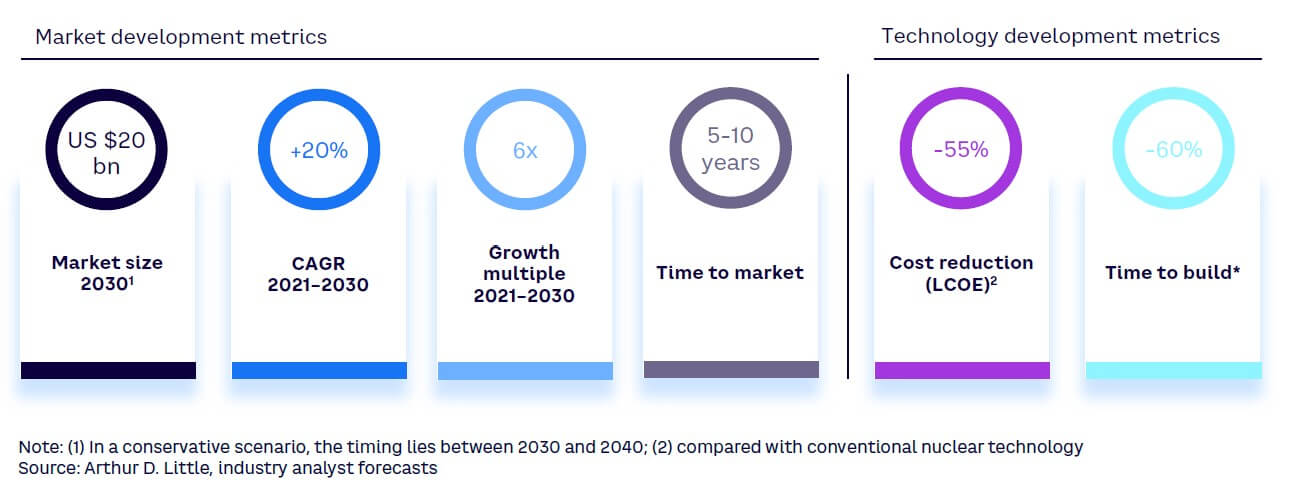
To meet the learning curve effects and economies of scale needed for SMRs to provide competitive LCOE or levelized cost of heat (LCOH) will require the emergence of a small number (five to six) of dominant global SMR designs. To allow for “mass manufacturing,” these designs will have to follow an internationally harmonized licensing process and allow only minimal customization by operators’ individual requirements.
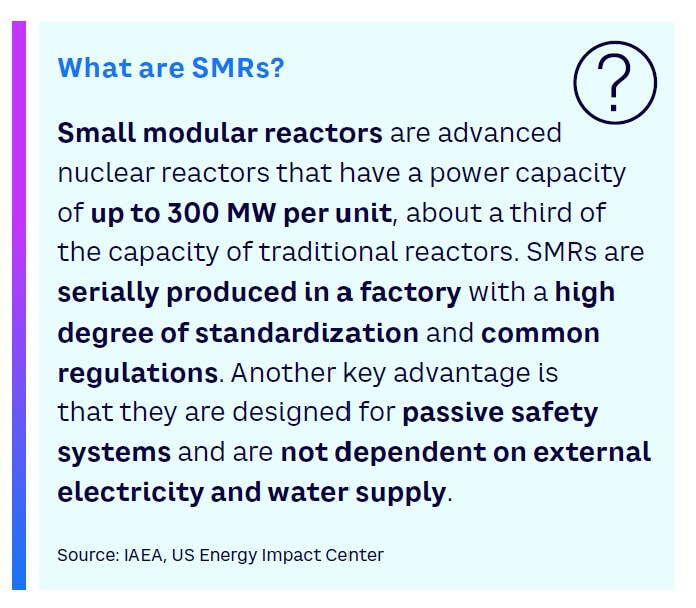
As a function of their smaller electrical output, SMRs can be installed into an existing grid or remotely off grid, providing low-carbon power for industry and the population. They can more readily slot into brownfield sites in place of decommissioned coal-fired plants, the units of which are seldom very large. Also, SMRs can be designed to produce heat for industrial processes as well as district heating (or cooling) purposes.
This makes SMRs more flexible than other renewable energy sources that would require either heat boilers or other energy conversion means like hydrogen to produce heat and steam. As such, they meet requirements to support net-zero ambitions for high-carbon emitters.
While nuclear reactors provide a steady source of energy that can regulate the output according to electricity demand, renewable energy alternatives such as wind and solar are intermittent, relying on weather conditions to deliver anticipated power needs. Pairing renewable energy technologies with SMRs in hybrid energy systems holds a great potential to increase the overall effectiveness from renewable sources by also increasing application diversity of energy.


To summarize, we believe that in the near future SMRs will empower companies, cities, and even entire nations by offering a scalable, reliable, and low-carbon way to secure current and future energy needs.
Artificial intelligence
Few of us have missed the aha moment presented by ChatGPT, a chatbot recently introduced to the public domain by Open AI, an AI research and deployment company with the mission to ensure that artificial general intelligence benefits all of humanity. ChatGPT is trained to follow an instruction in a prompt and provide a detailed response. It has proved that AI models are now so powerful that many of them pass the so-called Turing test, where the user cannot distinguish whether the counterpart is a human or a machine.
As an example, this is the answer from ChatGPT to the prompt, “Explain ChatGPT in simple terms”:[7]
“ChatGPT is a type of computer program known as a ‘language model.’ It is trained to understand and generate text in a way that mimics human language. It can be used to answer questions, write stories, or even generate code. It uses a type of machine learning called deep learning, which involves training a large neural network on a dataset of text. This allows it to understand and generate text in a way that is similar to how a human would.”
Problems previously thought to be intractable can now be solved by software and other computational systems that learn and evolve by integrating new data. AI will transform business as we know it and further accelerate computational technology’s integration into all economic sectors. Businesses today are facing challenges and encountering new levels of complexity above and beyond any historical precedence, while remaining stuck with many repetitive tasks and lots of unused data.[8] These are great targets for AI to drive efficiency and enhanced decision support.
However, performance of AI models is dependent on data quality to learn and deliver. Therefore, companies need not only build the right AI models, but also make sure that they possess and structure data correctly to successfully train the models.
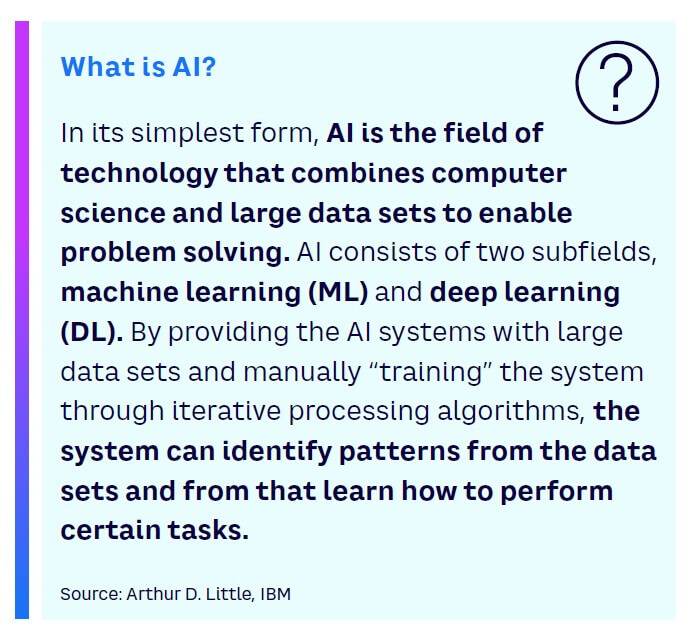
The benefits of AI are obvious: higher efficiency, higher productivity, and better decision-making. These are not new facts: 35% of companies globally are already using some form of AI in their business.[9]
Deep learning was partly enabled by big data and graphic processing units (GPUs), making it possible to access huge amounts of data and processing power for training AI solutions. Deep learning can ingest unstructured data in its raw form (e.g., text, images), and can automatically determine the set of features that distinguishes different categories of data from one another. Classical, or “non-deep,” machine learning is more dependent on human intervention, especially when it comes to the task of creating features. Research by ARK Invest suggests that by 2030, AI will have increased the output of knowledge workers by 140%.
“We’re at the beginning of a golden age of AI. Recent advancements have already led to inventions that previously lived in the realm of science fiction — and we’ve only scratched the surface of what’s possible.” — Jeff Bezos
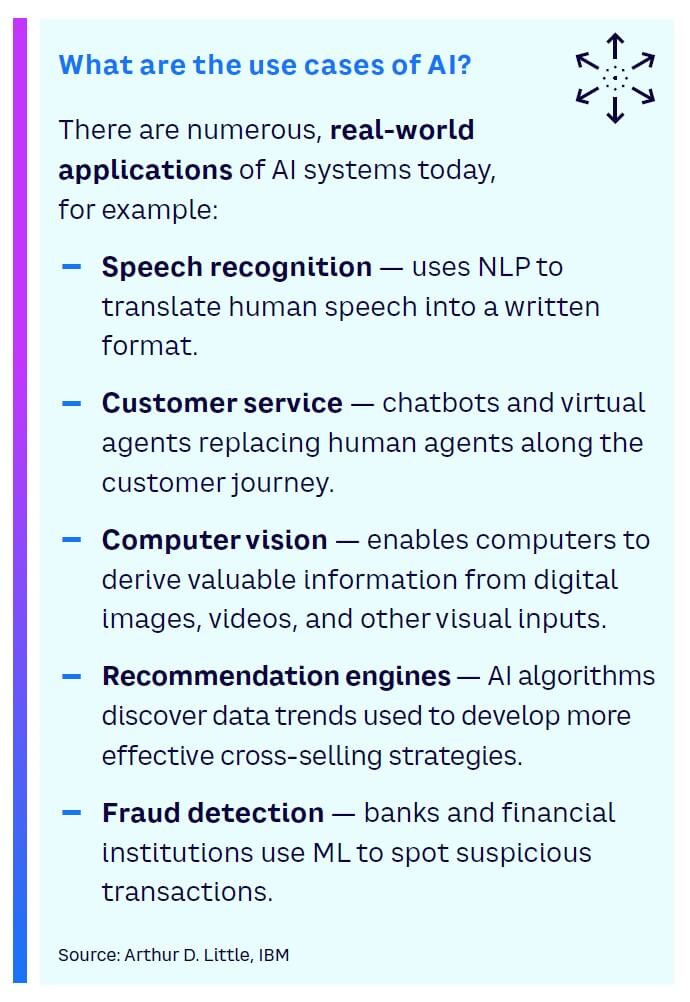
Developing at an exponential pace, AI training costs are declining at more than twice the rate of Moore’s law (see Figure 4).

ARK Invest shares its perspective on AI’s stunning performance development: “Given 240 trillion synapses, the cost to train a neural network equivalent in size to the human brain in 2021 would have been $2.5 billion and is likely to drop 60% at an annual rate to $600,000 by 2030.”[10]
AI is potentially the most disruptive and exponential candidate among the five technologies in this Report, and it is already seeing valuable use across industries.
Knowledge graphs are an emerging technology within AI.[11] They can represent complex relationships between heterogeneous data sets in transparent and scalable way and enable a wide range of AI use cases. ADL’s Digital Problem Solving (DPS) team has successfully used knowledge graphs in very diverse projects such as in the detection of early-onset disease patterns for rare disease patients, the investigation of passenger flows at one of the world’s largest airports, and for the analysis of regulatory compliance in the pharmaceutical industry, among others. Natural language processing (NLP) applications have reached superhuman performance in some tasks and are enabling more intuitive interactions between humans and machines, especially in combination with knowledge graphs.

To summarize, as we watch how AI is stretching the borders of what is possible and taking the human-machine collaboration to an entirely new state, we must ask ourselves: Have I truly understood the business-critical AI use cases that apply to my industry and my organization?
Blockchain technology
Cryptocurrencies are the most commonly cited examples of blockchain’s potential, but unfortunately they have also called the technology into question, as the (expected) crash of cryptocurrencies and stock markets followed the exaggerated hype. We advise corporate decision makers to avoid drawing negative conclusions about the relevance of blockchain technology for companies. The real magic of blockchain resides in the powerful management of decentralized digital transactions in complex ecosystems. From increased security and visibility to tracking complex variables related to sustainability and ethical sourcing, blockchain is set to facilitate organizations across industries to lower their costs and improve their performance.

Blockchains are perfect to document digital transactions reliably and comprehensibly for the participants, without the need for an intermediary to ensure trust. Decentralized processes in the global ecosystem — such as in supply chain management, for example — are perfect for this.
Today’s supply chain networks consist of multiple players that are connected and need to collaborate efficiently. There are numerous value-adding processes, handovers, and transactions involved before the products reach their final destination. Still, there are many unresolved issues regarding traceability, transparency, and accountability between involved parties since much of their work relies on trust and compliance. Supply chains are becoming more complex with the introduction of new logistics concepts enabled by integration of robotics and Internet of Things (IoT), such as autonomous delivery vehicles and product-monitoring devices. This has generated more data throughout the supply chain and raised concerns regarding transparency and security. Given support from adequate business processes, blockchain can add great value to supply chains, including improved traceability, security, automation, and speed.
“Anything that can conceive of as a supply chain, blockchain can vastly improve its efficiency — it doesn’t matter if its [sic] people, numbers, data, money.” — Ginni Rometty, former IBM CEO
A public blockchain, also known as an open or permissionless blockchain, is one where anybody can join the network freely and establish a node. Because of their open nature, these blockchains must be secured with cryptography and a consensus system like proof of work (PoW), which is the variant used to secure the Bitcoin network.
A private or permissioned blockchain, on the other hand, requires each node to be approved before joining. Because nodes are considered to be trusted, the layers of security do not need to be as robust. Blockchain provides immediate, shared, and completely transparent information stored on an immutable ledger that can be accessed only by permissioned network members. Among other things, a blockchain network can track orders, payments, accounts, and production. And because members share a single view of the truth, you can see all details of a transaction end to end.
The blockchain trilemma states that it is virtually impossible for a system to simultaneously achieve equally high levels of decentralization, security, and scalability. Realistically, blockchain networks can only have two out of three factors. Highly decentralized public blockchain networks (e.g., Bitcoin) have very high security but low scalability. More centralized private blockchain networks (e.g., among supply chain partners) have high scalability and security but at the expense of low decentralization.
Scalability for public blockchains can drastically improve up to 1000x if one is willing to accept a less decentralized and secure network (see Figure 5). There are many scaling solutions available, such as “sharding,” which splits the blockchain network into multiple smaller groups of nodes or parallel processing, or “payment channels,” temporary channels on which some transactions are transferred to reduce the load on the main chain and to improve throughput. The former will be implemented on the Ethereum Layer 1 blockchain, while the latter is implemented through the “Lightning network” as a Layer 2 scaling solution on the Bitcoin blockchain.
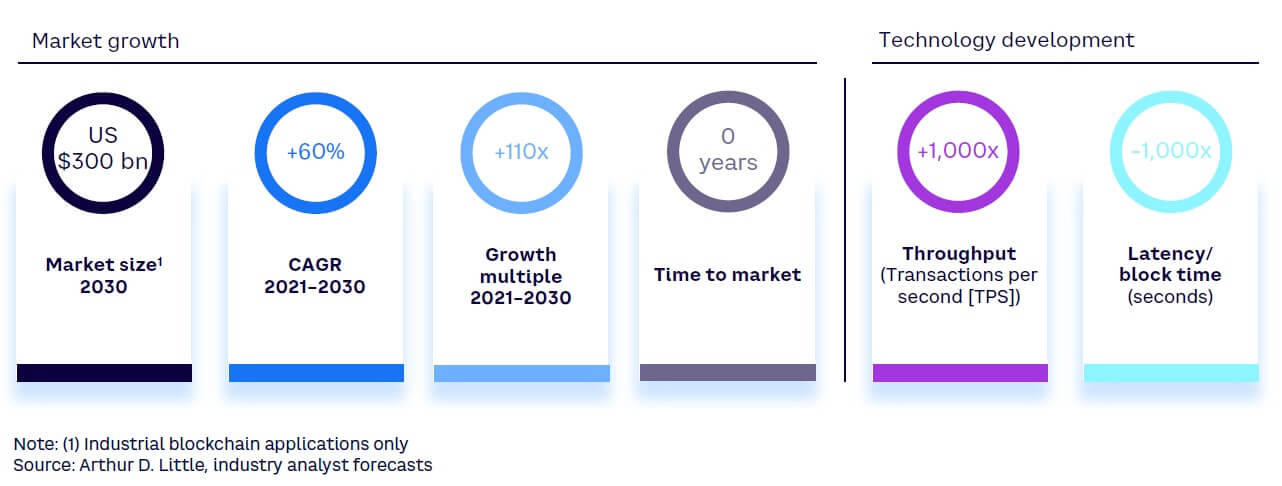
The market size for blockchain applications in the non-financial industry is forecasted to reach $300 billion in 2030, growing exponentially with a 110x increase from 2020. The technology is already being put to use across industries but is still in an early growth phase. Since the properties of blockchain lends itself for applications in most if not all sectors, the potential impact on business and society combined is huge.
Although initial industrial usage of blockchains has had a slower than expected take-up rate, the results of the survey we conducted with Blockchain in Transport Alliance indicate that industry still views blockchain as potentially disruptive. Over 70% of respondents believe blockchain could increase process efficiency, and nearly 60% said it had the potential to disrupt business models.
One specific sector with a large potential benefit from the use of blockchain technology is transportation. ADL worked with a large mobility provider to create immutable visibility of goods movement for all logistics partners involved in the supply chain (see Figure 6). Once changes of ownership are recorded through barcode scanning at the different trans-shipment points, data is securely stored in the blockchain and payments are automatically triggered.
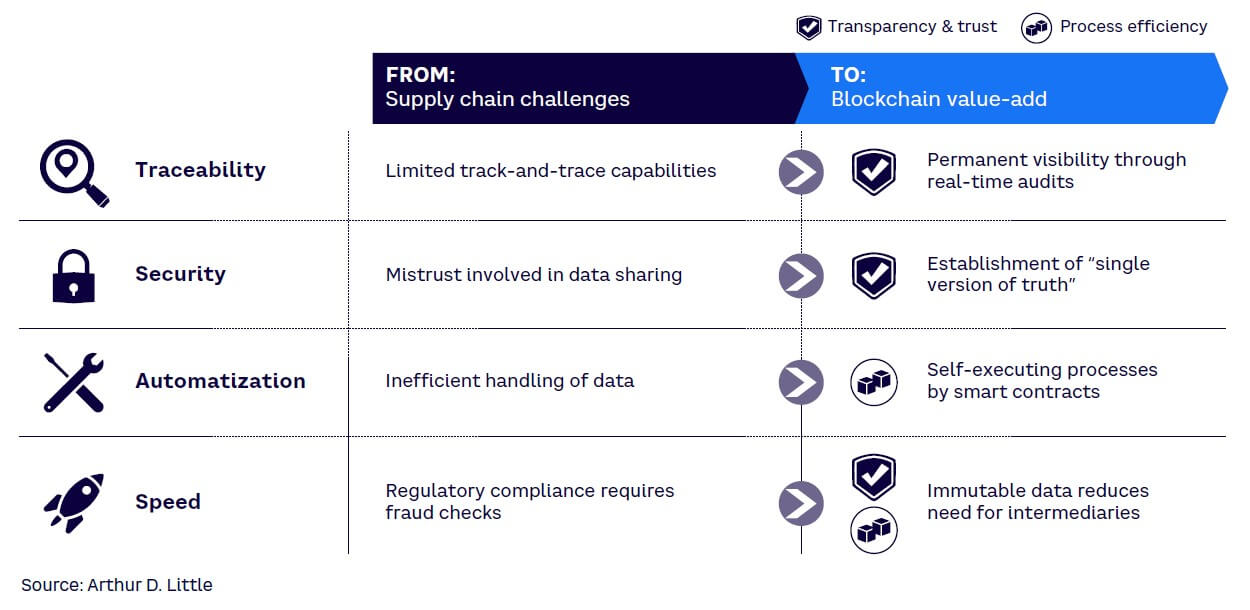
Self-executing smart contracts reduce processing of manual paperwork and help to prevent time delays, reduce human errors, and decrease the amount of additional work resulting from inefficient handling of data.
There are numerous examples of large industrial companies that have implemented blockchain technology in their operations. Renault, for instance, recently implemented blockchain to manage its entire supply chain documentation. The reason behind the decision to do so was that blockchain brings improved traceability, transparency, and accountability. The sharing of goods data is accurate and happens immediately between participants, meaning less time is spent on inefficient tasks such as documentation, trading files, emailing, or calling each other, and more time is spent on higher value-add activities. Inconsistencies in data that took hours in the past to resolve are now eliminated. As a result, Renault now has an increased transparency between partners and an increased reactivity vis-à-vis customers.
Another example is Maersk’s TradeLens platform, which applies blockchain technology to global supply chains via its trade document module, enabling secure cross-business information exchange. This helps to prevent delays that result from inaccurate documentation or slow information exchange.
In addition, experience has demonstrated that warranty-handling (e.g., automating insurance payouts) and demand-planning processes between manufacturers and suppliers can be significantly streamlined by drawing on secure information exchange and self-executing contracts.
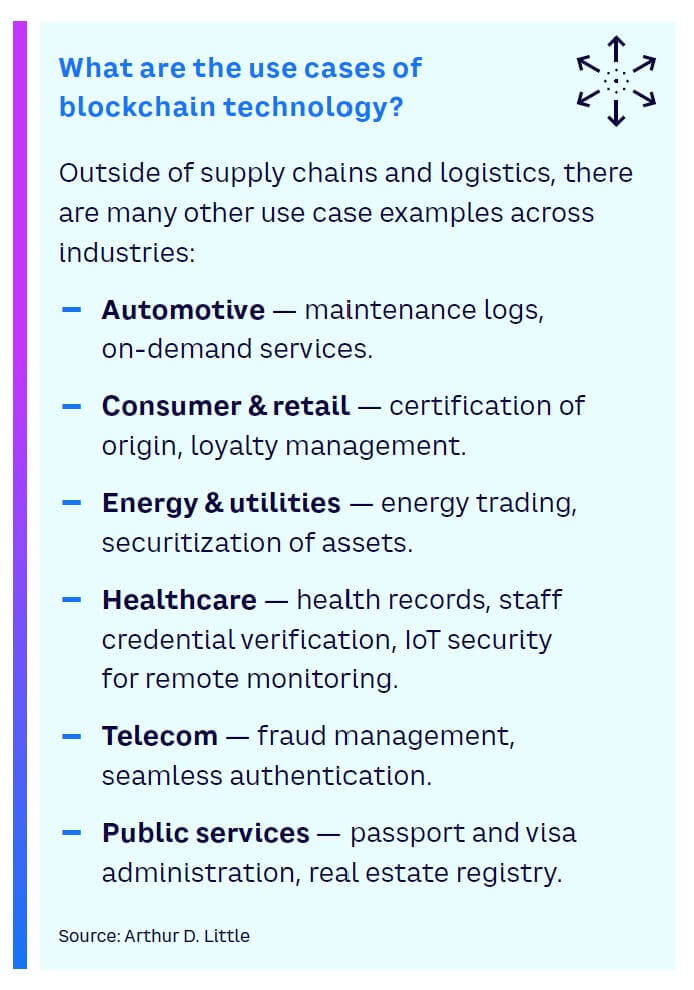
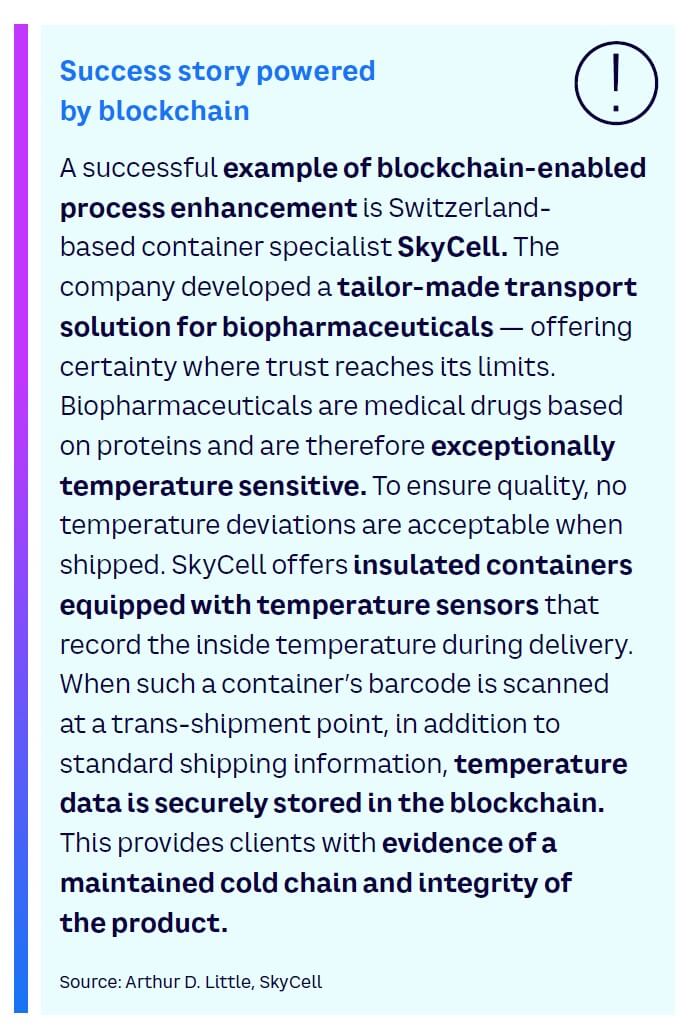
To summarize, we are confident that blockchains will play a key part in enabling crucial characteristics in supply chains across the globe — in the areas of security, traceability, automation, and speed — thus securing trust at a time of geopolitical fragmentation.
Quantum computing
Quantum computing is among the most hyped technology topics at the moment and is on every tech giant’s agenda. IBM, Google, Microsoft, and others are aggressively investing in quantum computing. Such computers process data at massive speed with great power savings, which ultimately redefines what is possible in the AI and ML fields. The last few years have seen an acceleration of activity in quantum computing, with venture capital increasing 50% to over $1 billion from 2020 to 2021 and estimates of total global investment now reaching $25 billion.[12]

At present, the technology is not yet ready for practical use. There are still massive technical challenges to overcome, and it will still be a few years before the hardware will be available for businesses. However, as soon as the technology is available, there will be a massive disruption of the IT world, and with it the application world as well. We advise businesses to prepare for this point in time now to avoid being left behind if and when a breakthrough occurs.
The process by which qubits can be harnessed to perform calculations is nothing like that of a conventional computer, and the technical challenges to build a usable quantum computing device are immense. Without some in-depth knowledge in quantum physics and mathematics, it is quite impossible to really grasp how it works. But it’s not necessary to know how a modern computer works, either. What is crucial is to know how best to use the technology.
“Our machine performed the target computation in 200 seconds, and from measurements in our experiment we determined that it would take the world’s fastest supercomputer 10,000 years to produce a similar output.” — John Martinis, CSO, Quantum HW, Google
A common misconception about quantum computing is that it will ultimately replace conventional computing because of its much greater processing power. This is not the case. In fact, quantum computing will only ever be superior to conventional computing for solving certain types of complex problems. These are problems involving systems with multiple elements, variables, and interactions, in which the solution complexity quickly scales up exponentially beyond the reach of conventional computing: so-called intractable problems.
Quantum computers are suitable for intractable problems because they have a theoretical ability to perform exponentially increasing numbers of calculations simultaneously: a quantum processor with N qubits can theoretically perform 2N simultaneous calculations, so each additional qubit doubles processing power. Conventional computing, even if Moore’s law were to continue forever, could never achieve this.
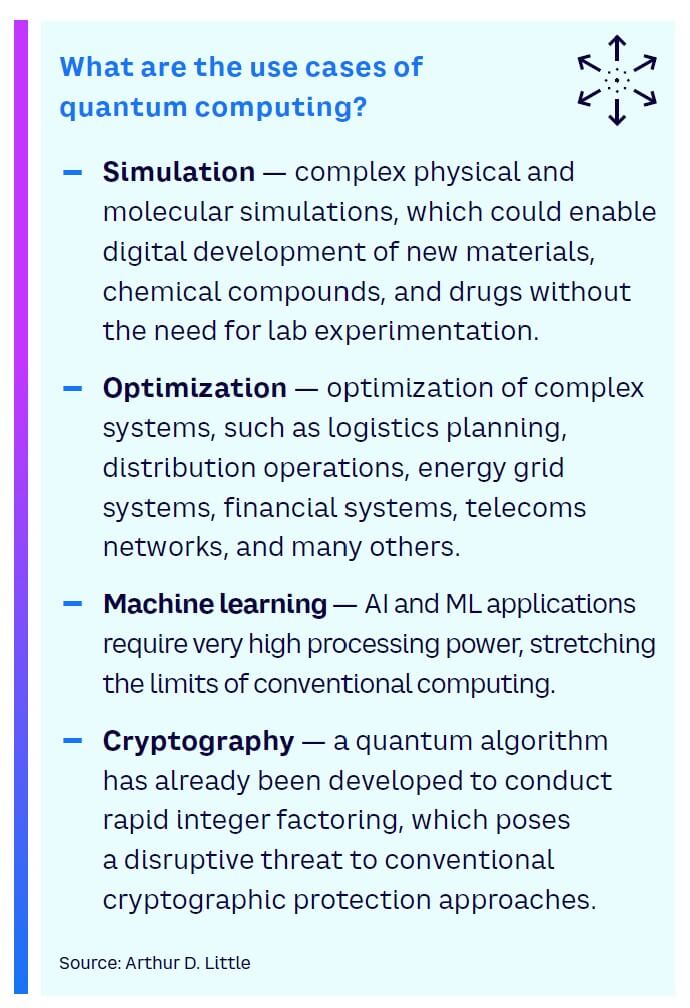
Although commercial breakthrough of quantum computing remains many years away, a lot of groundwork is being done (see Figure 7). Behind Big Tech there are now more than 450 quantum computing start-ups worldwide. The roadmap for completion of new prototypes promised by the ecosystem is extensive, with at least 20 new devices to be announced by the key players between now and 2030. A conservative assumption would be that the key milestone of achieving a fault-tolerant large-scale quantum computer might occur in the period 2030-2040. One promising avenue in the shorter term is hybrid quantum computing, in which quantum computing is used as an accelerator for a conventional high-performance computer to run specially designed hybrid algorithms.
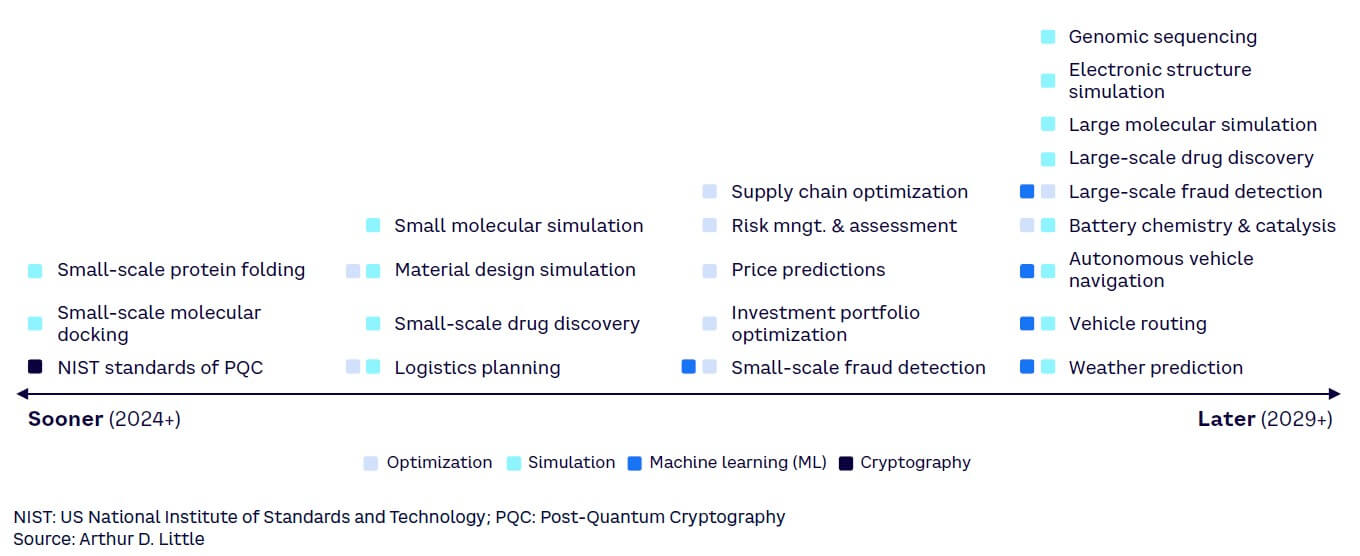
But quantum computing also comes with a challenge: mature quantum computers will be able to break the most widely used security protocols in the world. For example, until very recently, methods of encryption based on prime factorization were considered unbreakable and were used to safeguard everything from email to banking to credit cards. Quantum algorithms can break these systems. Given the accelerated advancements of quantum computing, everything secured with prime factorization could become insecure in the years to come. Developing and migrating to “quantum safe” encryption methods will therefore be of significant importance.
From an economic point of view, growth projections for the quantum computing market up to 2030 vary from less than $5 billion to more than $60 billion, depending on the source (see Figure 8).
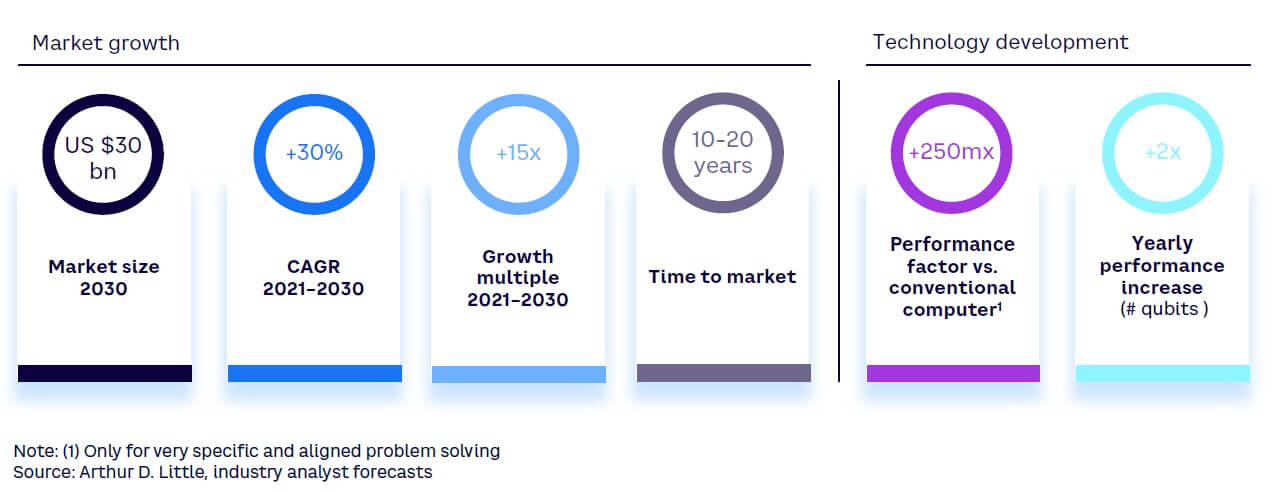
What does all this mean for businesses? Even if the hardware is not yet widely available, it is nevertheless advisable to start dealing with the topic now:
-
Quantum computers will suddenly be available in a few years. There will then be a real run on the services and the available experts. Therefore, we recommend that you start building up the competence in your company now. Otherwise you will be left behind later.
-
Conventional software no longer runs on quantum computers because the architecture is completely different. But software prepared for quantum computers also runs on conventional hardware. Therefore, it should already be switched to future-oriented software in certain segments.
-
Quantum computing–optimized algorithms are already available today and can accelerate certain processes on conventional hardware. This software can then be run immediately on the new hardware later and allows an immediate significant acceleration.
Forward-thinking organizations see quantum as an opportunity to leap ahead of the competition. Of large enterprises surveyed, 40% are already experimenting with quantum computing.[13]

Cell & gene therapy
Imagine a world where your health situation was not determined by chance and luck at birth. For example, a world where it wasn’t possible to be born with, or to develop later in life, faulty genes that cause diseases such as cancer, heart disease, hemophilia, or blindness.
In the future, people may have greater control over their own fates. It may be possible, in fact, to level the playing field. The convergence of next-generation DNA sequencing, AI, and gene editing has the potential to transform healthcare. These advances could accelerate the pace of scientific discovery, personalizing medicine to cure disease instead of masking symptoms.
Cell therapy and gene therapy are overlapping fields of biomedical research and treatment. Both therapies aim to treat, prevent, or potentially cure diseases, and both approaches have the potential to alleviate the underlying causes of genetic and acquired diseases, though they work differently.
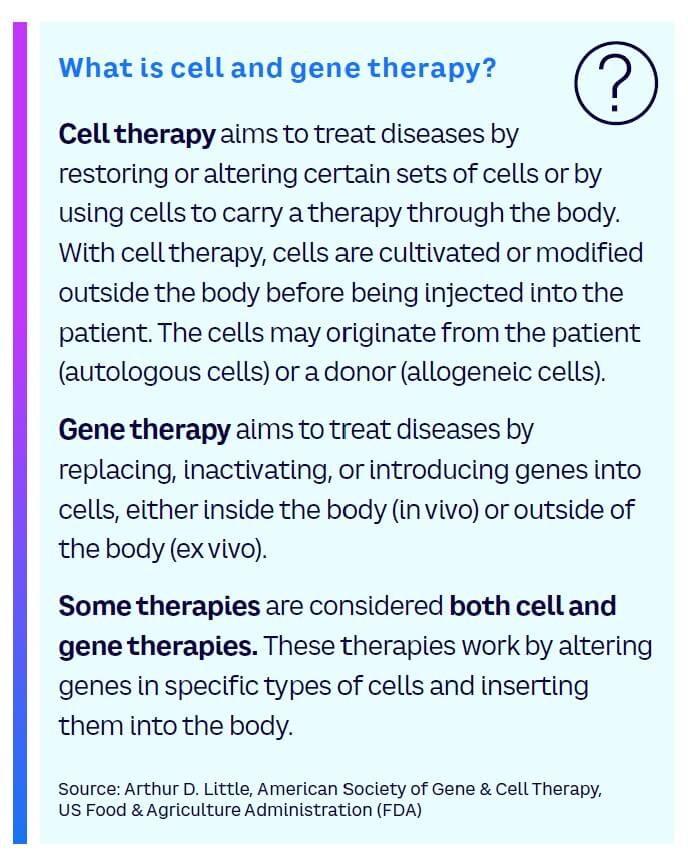
Genes and cells are intimately related. Within the cells of our bodies, there are thousands of genes that provide the information to produce specific proteins that the cells consist of. Cells are the basic building blocks of all living things; the human body is composed of trillions. The genes provide the information that creates this blueprint, enabling and giving different cells their different purposes. Groups of many cells make up the tissues and organs of the body, including muscles, bones, and blood.
Sometimes certain genes, or parts of them, are defective or completely missing from birth. This is typically referred to as a genetically inherited mutation. In addition, healthy genes can mutate (i.e., change) over the course of our lives. These acquired mutations can be caused by environmental exposures. The good news is that most of these genetic mutations do not cause disease — in fact, it is because of beneficial mutations that humans evolved into what we are today. However, it is inevitable that some mutations (either inherited or spontaneous) can cause, for example, developmental disorders, neurological diseases, and cancer.
“Imagine a world where no life is limited by genetic disease and the ambition of gene therapy to treat or possibly prevent disease is realized for the millions of people living with an inherited condition.” — Jeff Marrazzo, Founder, Spark Therapeutics
The scientific field for gene therapy products is fast-paced and rapidly evolving — and is now finally ushering in a new approach to the treatment of cancer and other serious and rare diseases. The first gene therapy targeting cancer was approved by the US Food and Drug Administration (FDA) in 2017. Fast-forward five years and the number of cell and gene therapy treatments approved by the FDA has jumped to 27. The wide array of therapies includes one for spinal muscular atrophy and others for cartilage defects of the knee, retinal dystrophy, several types of cancer, and thermal burns.
The cell therapy field is moving fast as well. One of the most widely known successful cell-based gene therapies, CAR-T (chimeric antigen receptor T-cell), involves the use of genetically reengineered versions of a patient’s own T-cells to find cancer cells and defeat them. As of 2022, there are six CAR-T therapies licensed for use by the FDA, almost all for cancer indications. CAR-T has pushed the boundaries of medicine, and the success observed in patient treatment has created interest in the use of CAR-T to treat other types of tumors, including solid ones, as well as other genetic diseases.
This is evidenced by the large number of completed and ongoing clinical trials reported by the National Institutes of Health (NIH) involving the use of CAR-T (~700), with the large majority of these targeting a range of cancers and a smaller share targeting chronic, infectious, and autoimmune diseases. The global CAR-T cell therapy market opportunity alone is expected to surpass $15 billion by 2028.[14] An important aspect of realizing this potential will be scaling up using allogeneic (cells from a donor) or “off-the-shelf” CAR-T, which has moved into early-phase clinical testing with the hope that it will offer many advantages over autologous (cells from the patient) regimens. The key advantages are: shorter manufacturing time, lower cost, and a more potent therapy using healthy donor cells.
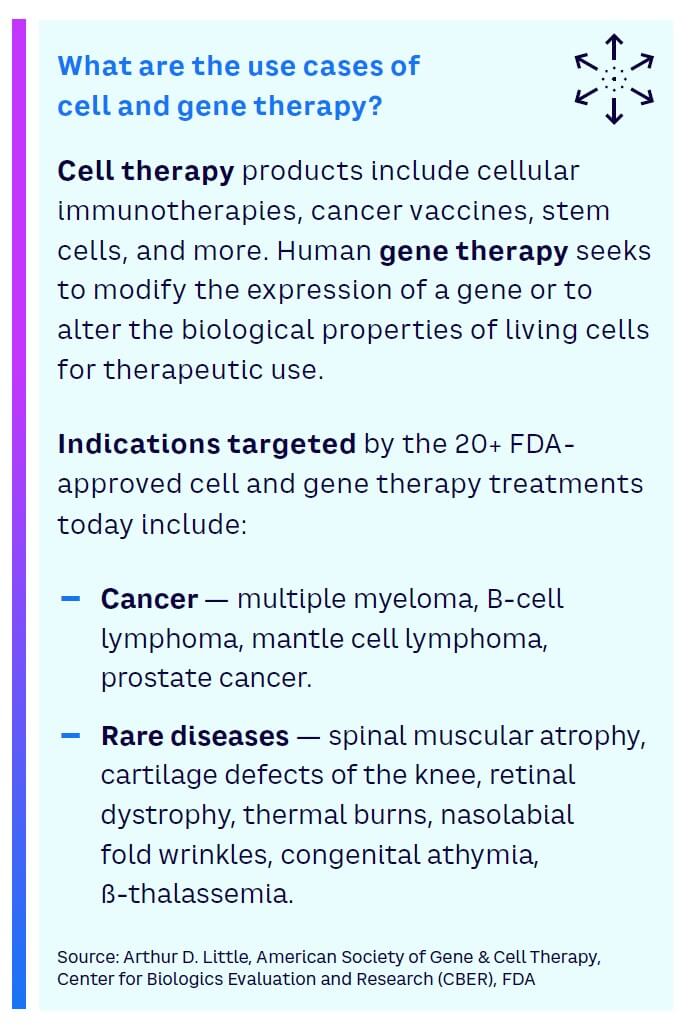
Even with the massive disruption of the healthcare sector caused by COVID-19, the pace of activity in cell and gene therapies has not slowed (see Figure 9); if anything, it has accelerated in the past year. In 2020, total financing in regenerative medicine doubled to almost $20 billion from just under $10 billion the year before, according to the Alliance for Regenerative Medicine.
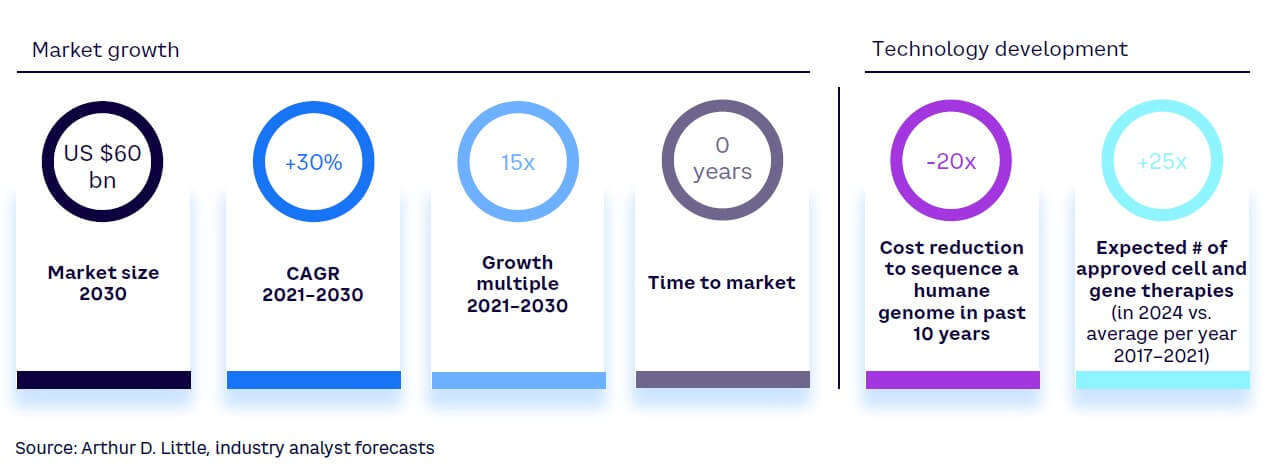
Cell and gene therapies are examples of “curative treatments;” time-limited treatments that remove the symptoms of a disease through permanent correction of the underlying condition. In contrast, a treatment in which a patient remains healthy only with the continuous taking of a pill, injection, or infusion only masks the actual condition, temporarily hiding symptoms or stopping disease progression for the moment. This is not curative. Essentially, patients who previously had to rely on ongoing medication can now be cured through specific, time-limited courses of treatment, transforming their lives.
Once a patient who suffers from a particular condition has been successfully treated, the need for additional medical care is significantly reduced, and thus the product lifecycle (medical treatment) will drastically shorten — putting a high premium on speed and creativity in clinical and regulatory approaches and on replenishment of the pipeline. With curative treatments, payers’ expenditure drastically shifts from ongoing, long-term, and relatively low-cost drugs to large, front-loaded therapy costs. As a consequence, the revenue profile for therapy providers will shift accordingly, implying a need to change the pricing strategy in order to recoup investments over a far shorter time span.
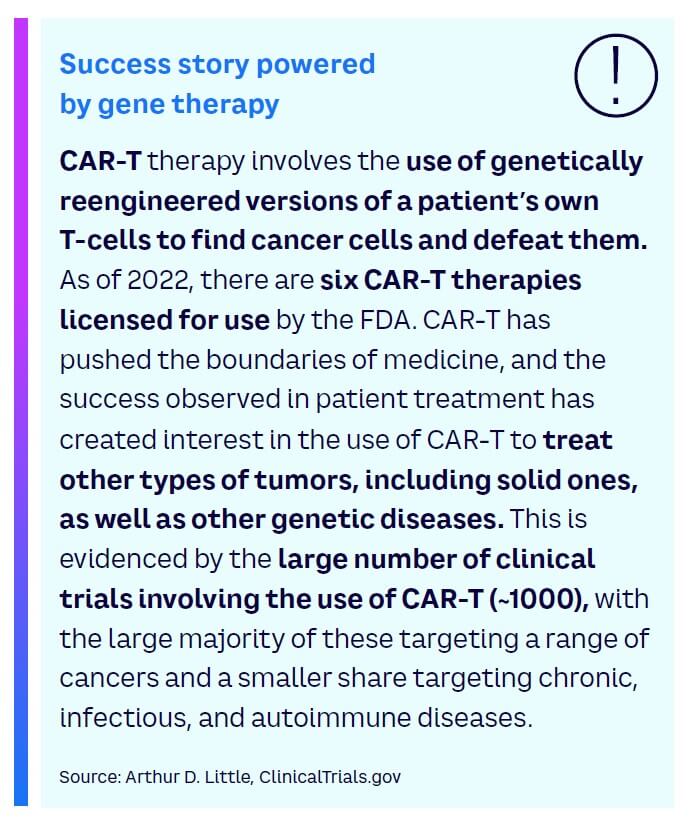
To summarize, this new technology will disrupt the entire healthcare ecosystem and lead to a number of consequences for patients, policy makers, payers, providers, and pharma companies alike.
The wider relevance of cell and gene therapy for business leaders across industry sectors is more apparent than it may seem. Without it, and specifically without the mRNA vaccines for COVID-19 that it enabled, more severe disruption of both the demand and supply side of the economy arguably would have impacted businesses, irrespective of industry and geography, considerably more than it did and still does. Furthermore, advances in biomedical therapy will contribute to more curative treatments, better medical outcomes, and improved vaccines. These will accrue as value for business and society at large.
4
TURNING TECHNOLOGY INTO BUSINESS IMPACT
In today’s complex and uncertain world, only organizations that understand and harness technology to become more agile, innovative, productive, and sustainable will succeed. Transforming through technology requires new skills, capabilities, and leadership, combined with the ability to understand and apply technology where it delivers its greatest benefit.
Business leaders should therefore begin by analyzing the short-, medium-, and long-term technology trends that are most relevant within their organization to drive future success. Leading companies understand that this requires a continuous and systematic approach to yield tangible results over time (see Figure 10).

Technology trends radar
To facilitate monitoring and assessment of technologies in fields relevant to the company or organization in question, ADL successfully deploys a “technology trends radar” (see Figure 11). In essence, it brings strategic and tactical clarity on how and when to leverage technologies depending on maturity level and expected value creation. Within each field, technologies are classified and prioritized accordingly — from “adopt” through “trial” and “assess” to “hold.” Depending on purpose and need, the scope of the technologies included on the radar varies:
-
Multi-industry — broad outlook covering multiple focus industries to discover technology trends across industry borders.
-
Industry-tailored — focusing on the evolving technology trends impacting one industry.
-
Single-field — focusing on a single technology field (e.g., AI and its use cases).
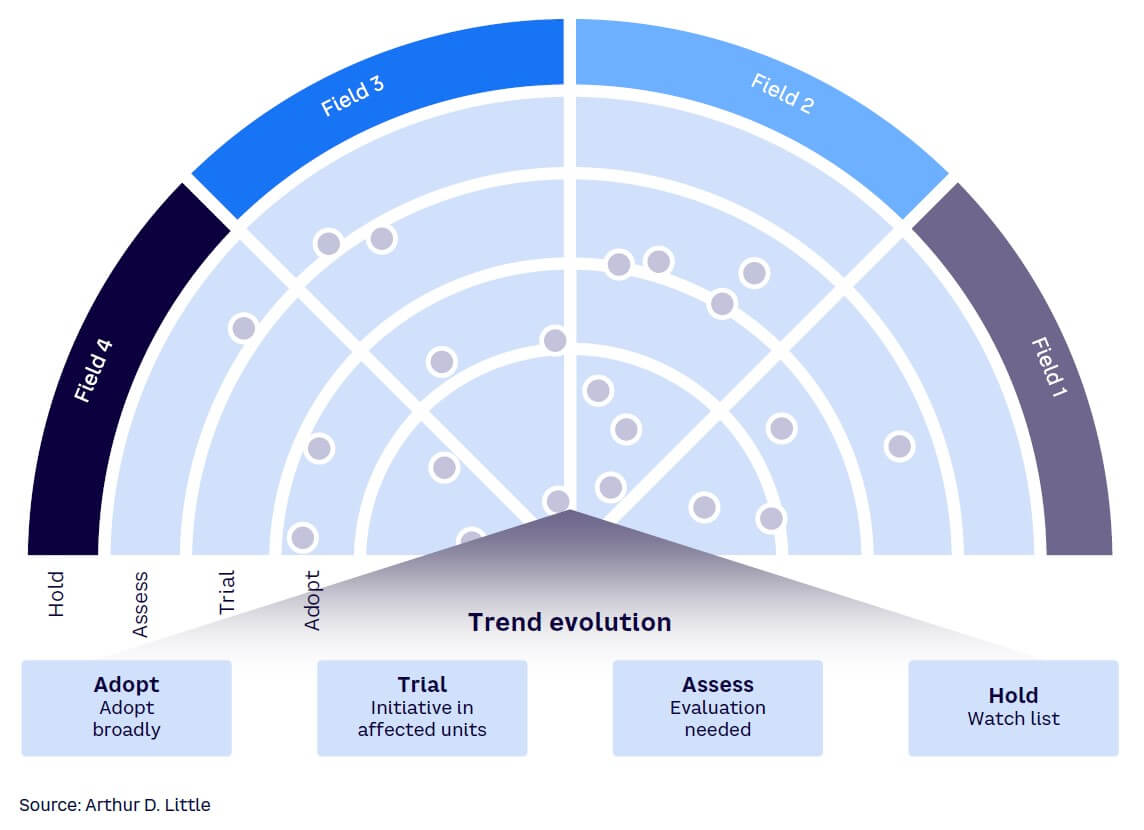
The radar can be used to track trends over time, conduct deep dives in specific fields or trends, as well as assessing/benchmarking your company’s presence. Similar approaches can be used at a national level through technology foresight[15] to identify areas of technology that can form the basis of a national innovation strategy.
Assessing and classifying the technologies into adopt, trial, assess, and hold, in each technology field, enables business leaders to:
-
Understand the inflection points of each technology field and their implication for business and society (e.g. creating new business models that transcend industries, solving social problems).
-
Identify non-technological key issues for each field (e.g., changing consumer behavior).
-
Devise a plan for how to access people and organizations that have a deep understanding and ownership of the key technologies in each field (e.g., internally, externally).
-
Design the most appropriate methods to acquire key technologies (e.g., make, buy, partner).
The insurance groups Munich Re and ERGO released the Tech Trend Radar 2021 supported by ADL (see Figure 12), including future technology trends, use cases, and their corresponding (technology-aligned and enabled) insurance solutions offerings.
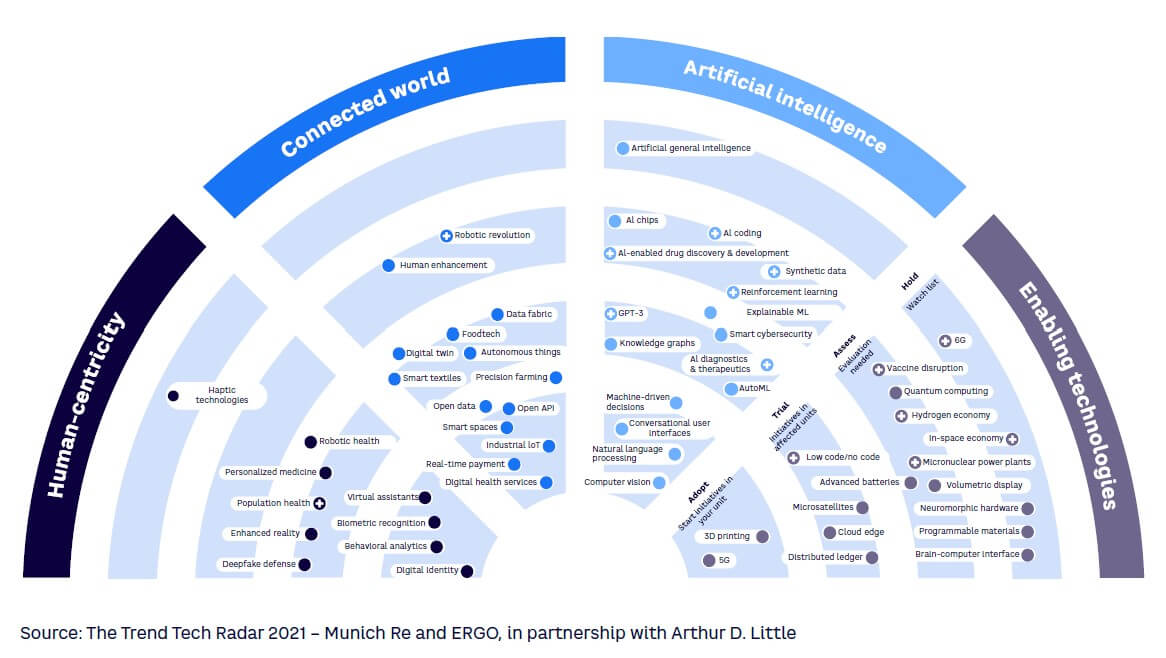
Developing a technology trends radar will help organizations identify new growth opportunities and “no-regrets moves,”[16] preventing organizations from making fundamental mistakes, such as jumping on technology bandwagons where they are unlikely to derive value. Indeed, through its rigorous analysis, a technology trends radar can highlight not only where to focus but also where not to invest, and identify which areas can be addressed through technology adoption rather than technology leadership.
Ultimately, the technology radar is a tool to help make decisions on where to place the next business “bets.” However, although it is a powerful framework, the technology trends radar as described in this Report needs to be understood in the right context. The technology deep dives behind the technology radar dots should look beyond the science maturity, pace of innovation, IP landscape, and key players to give the radar meaning and value.
Working with marketing and commercial teams to provide the external business context and understanding the organization’s internal capabilities and their existing relationships and partnerships in the innovation ecosystem will help the company determine the strategic route that creates the best value. This may mean exploring new business models, developing new capabilities, or finding new companies to partner with to combine attributes needed to develop radically new solutions. Indeed, the findings from a technology trends radar may necessitate a reevaluation of our understanding of the competitive landscape and how to win. In an era of technology acceleration and convergence, developing partnerships with “frenemies” to combine core technologies, capabilities, and reach to fully exploit new technologies or new markets faster is becoming increasingly common.
Thus, successful deployment ultimately hinges on the individual organization’s strategy, capabilities, resources, processes, and organization. Upstream, a technology and innovation strategy needs to be developed and aligned with the business strategy. Downstream, capabilities, resources, processes, and organizational models need to be sharpened to leverage the results from the technology trends radar and ensure the commensurate value creation.
CONCLUSION
In the current challenging business environment, where the promise of growth through development and adoption of disruptive and exponential technologies is affected by geopolitical and macroeconomic trends, a clear and concise “helicopter view” is critical to inform strategic corporate decision-making. A technology radar becomes an indispensable piloting instrument to navigate technological complexity and geopolitical and macroeconomic trends. To stay ahead of technology trends that will shape the future success of the company, business leaders need not only activate their radar, but also build capabilities to correctly interpret incoming echoes and successfully use the information for navigation.
From knowledge and experience across multiple industries, ADL has identified three critical success factors:
1. Build and maintain critical competencies
-
Boards and CEOs should commit to invest in technology competence building — the foundation for identifying which technologies to invest in and which to not invest in.
-
Early planning in developing a technology competence roadmap can save a lot of regrets later. Too many companies only carry out succession planning to maintain current competencies, but do not build capabilities for the future to guide recruitment, acquisition, and training. Most importantly, new capability champions can then be identified to lead the creation and exploitation of these new capabilities.[17]
-
To ensure strategical and tactical relevance, technology competencies must be renewed on a recurring basis.
2. Track strategic initiatives — and keep learning
-
A high-performing board and CEO should not only be able to deploy the radar, but also understand the flight dynamics and where the engines are taking the plane to regularly adjust the flight plan.
-
Stop relying on someone else’s radar to guide you through the standard approach. Build your own on-board radar to create a different perspective. Some companies that perform best in dynamic environments where technology is changing rapidly focus not on product success (a lagging indicator) but on “What have we learned?” and “How does that help us improve?” Without dedicated experimentation to get data and insights that none of your competitors have, you have only the commonly available view of the industry and cannot create an alternative flight plan.
-
There is a big difference between investing in new products and service development and investing in new capabilities. Most companies lack a good understanding of their own technical capabilities and often underestimate the capabilities of competitors or the ecosystem they could be leveraging. These can be a source of strategic partnership initiatives.
-
The board needs systems to create transparency and a “single source of truth” in technology investments and capabilities, so it can track and challenge technology capability-building initiatives to ensure these align with the company’s overall strategy.
3. Devote time to ensure long-term success
-
As these questions are complex, the focus must center on value-driving technology, debating alternative strategies and evaluating the allocation of resources.
-
High-performing boards and CEOs use a diverse range of functional expertise to evaluate technology options and devote twice as much time on strategically important issues, like technology management, as do low performers.[18] This means both having meaningful data and investing leadership time in regular meetings to manage this.[19]
Notes
[1] From a concept created by Arthur D. Little Managing Partner Petter Kilefors and Principal Jonas Andrén.
[2] Ritchie, Hannah, et al. “Energy.” Our World in Data, 2022.
[3] Weill, Peter, Stephanie L. Woerner, and Aman M. Shah. “Does Your C-Suite Have Enough Digital Smarts?” MIT Sloan Management Review, Spring 2021.
[4] Weill, Peter, et al. “It Pays to Have a Digitally Savvy Board.” MIT Sloan Management Review, Spring 2019.
[5] Schneider, Mycle, and Antony Froggatt. World Nuclear Industry Status Report 2021. September 2021.
[6] Dalton, David. “Generation IV/Economic Modeling Compares Costs of SMR to Conventional PWR.” NUCNET, 15 October 2020.
[7] “ChatGPT: Optimizing Language Models for Dialogue.” OpenAI, 30 November 2022.
[8] For more on the topic of AI, see Eiden, Michael (ed.). “Navigating the Prospects and Perils of AI.” Cutter Business Technology Journal (renamed Amplify), Vol. 34, No. 5, 2021.
[9] “IBM Global AI Adoption Index 2022.” IBM Corporation, May 2022.
[10] “ARK Big Ideas Summit.“ ARK Invest, 2022.
[11] For more on knowledge graphs, see: Eiden, Michael (ed.). “Connecting the Dots with Knowledge Graphs.” Amplify, Vol. 35, No. 7, 2022.
[12] Meige, Albert, Rick Eagar, and Lucas Könnecke. “Quantum Computing.” Arthur D. Little Viewpoint, 2022.
[13] D-Wave Systems, 451 Research, accessed December 2022.
[14] Global CAR T Cell Therapy Market Opportunity & Clinical Pipeline Insight 2028. Kuick Research, May 2022.
[15] Khoury, Raymond, et al. “Technology Foresight: Anticipating Future Impact.” Arthur D. Little Viewpoint, 2022.
[16] “No-regret moves” are defined as strategic decisions that have positive payoffs in any future scenarios. These may be building capability or capacity; investing in technology platforms that are key enablers; or technologies, features, or services that will give the organization the “right to play” in future markets. See: Courtney, Hugh, et al, “Strategy Under Uncertainty.” Harvard Business Review, November–December 1997.
[17] Davies, Colin, et al. “Your Most Valuable Asset: Insight into Resource & Competence Management.” Arthur D. Little Viewpoint, June 2015.
[18] “Digital Transformation Pulse: Connected Industry.” Arthur D. Little, Telia, and Ericsson, 2022.
[19] Based on findings from the Arthur D. Little Global Innovation Excellence Benchmark v9.0, 2023.
DOWNLOAD THE FULL REPORT
33 min read • Strategy
Time to renew your pilot’s license?
Five technologies board members and CEOs must keep on their radar screens

DATE

Executive Summary
Just as the pilot must refresh and renew capabilities continuously to be fit for flight, so must the business leader. A decade of challenging business conditions marked by geopolitical and macroeconomic headwinds has led to the promise of disruptive and exponential technologies.
A clear helicopter view, more than ever before, is critical in separating the winners from the less successful. Board members and CEOs need a better understanding of disruptive and exponential technologies and their impact on business.
In this Report, we present five key technologies and explain why they are essential to be on the radar for every board member and CEO, and how they should use them to their advantage.
1
TECHNOLOGY: THE ENABLER OF BUSINESS ACTIVITY
Meaningful businesses operate and thrive in a fundamental ecosystem consisting of five factors:[1] humans, machines, capital, energy, and rules. Technology has always played a crucial role in shaping this ecosystem to improve performance and to overcome challenges, and this remains true today (see Figure 1):
-
Humans recently have been challenged by the COVID-19 pandemic, disrupting societies and economies on a global scale. However, the rapid development and release of vaccines based on new mRNA technology, as well as processes to bring them to commercial use, thwarted an even more catastrophic scenario.
-
Machines (computers) are pushing up against physical limits on the number of transistors that can fit on a chip, thereby struggling to deliver on Moore’s law (roughly a doubling every two years) and associated performance increase. Major advancements in artificial intelligence (AI) and quantum computing, however, open up a potential step change in productivity.
-
Capital and markets play a key role in allocating resources between sectors and over time. Adequately priced and efficiently distributed and deployed, capital acts as a powerful lubricant in the ecosystem, and we have relied on this to support the last decade of growth. However, the current situation, characterized by a lack of capital and underinvestments, threatens a discontinuity in our ecosystem performance.
-
Energy — cheap, abundant, and clean — is a must-have for sustainable ecosystem growth. Today, this is not the case, as 80% of global prime energy still comes from climate-degrading fossil fuels.[2] Energy prices are soaring and intermittent renewable sources do not generate enough when needed. Advanced nuclear power, however, can provide the stable, safe, low-carbon energy source that the world desperately needs.
-
Rules and regulations are prerequisites for well-functioning markets. Current geopolitical trends characterized by a breakdown of trust between countries and trade blocs is hampering free trade, leading to a break up and regionalization of yesterday’s global supply chains. Blockchain technology, with features such as cryptographic trust and transparency, can contribute to making supply chains more efficient, resilient, and secure.

All in all, we believe that the 2020s will be very different from the 2010s, requiring businesses to assess and adapt their playbooks.
Technology can help us address, mitigate, and overcome challenges, but only if they are understood and harnessed by key decision makers in business.
2
DISRUPTIVE, EXPONENTIAL & CONVERGENT TECHNOLOGIES
Never before have there been so many innovation platforms in concurrent development, reinforcing each other and creating new and previously unthinkable use cases. These platforms span a number of disruptive, sometimes exponential, and often convergent technologies.
These technologies are significantly altering the way that consumers, industries, and businesses operate. At the same time, the pace at which they are evolving in terms of performance is in many cases increasing on an exponential scale, with a significant impact on business and society as a whole.
Convergence across technologies will amplify their potential. For example, the convergence of robotics, battery technologies, and AI is likely to fundamentally alter the cost structure of transportation. And the convergence of next-generation DNA sequencing, AI, and gene therapy will enable personalized medicine and thus has the potential to create a new golden age for healthcare. A third example is the convergence of application programming interfaces (APIs), social platforms, and blockchain technology, with the potential to integrate business and consumer marketplaces in ways that were not previously possible.
These transformative technologies are approaching important tipping points as performance increases and costs decrease, leading to increased demand across industry sectors. In fact, Arthur D. Little (ADL) analysis shows that market capitalization for the above-mentioned technologies combined has already cleared the US trillion-dollar mark and is forecasted to grow 15x by 2030.
The corporate competence deficit
Sadly, it seems that many top management teams and boards of directors don’t have the capabilities and track records required to harness and leverage disruptive technologies.
According to a Massachusetts Institute of Technology (MIT) study[3] of about 2,000 companies published in March 2021, only 7% were led by technologically competent teams; that is, a team where over half of the members are tech savvy, with a firm understanding of how emerging tech will shape their company’s success. Unsurprisingly, those companies outperformed the rest by 48% in terms of revenue growth and market valuation. We believe this is because they can identify the benefits of new technologies and make investments in developing their capabilities and then outcompeting with new products, services, and business plans.
Company boards aren’t that different either; an earlier MIT study of around 3,000 companies with over US $1 billion in annual revenues showed that 76% of boards weren’t tech savvy — be it in terms of directors’ backgrounds, the number with tech experience, or the manner in which boards interacted with executives on technology-related issues.[4] Interestingly, companies with three or more tech savvy directors on their boards reported 17% higher profit margins and 38% higher revenue growth than those with two or fewer directors.
We at ADL believe that bridging the corporate competence deficit with regards to disruptive technologies should arguably be one of the most pressing issues for every board and CEO across all industry sectors.
3
FIVE KEY TECHNOLOGIES TO GET ON YOUR RADAR
In helping our clients across all industries create value by linking people, strategy, and technology, we have the knowledge and experience from working with all the innovation platforms and disruptive technologies mentioned in Chapter 2. In this Report, we have selected five technologies that will play pivotal roles in shaping the future of business and society:
-
Small modular reactors
-
Artificial intelligence
-
Blockchain technology
-
Quantum computing
-
Cell and gene therapy
Although we acknowledge the difference between AI as a “general-purpose” technology and cell and gene therapy as more “industry- specific,” we firmly believe that all five have an impact ranging far beyond any individual industry sector, and as such are of great importance to most, if not all, business leaders.
For each of the five technologies, our objective is to provide answers to the following questions:
-
What is it?
-
Why is it important?
-
What are the use cases?
-
What are the success stories?
In aggregate, according to industry analyses, the market size of these five technologies is expected to grow exponentially (~20x) from ~$100 billion in 2021 to ~$2.2 trillion in 2030, corresponding to 40% CAGR (see Figure 2). By 2029, it will surpass today’s size of the global passenger cars market!

Small modular reactors
Following the first discovery of nuclear fission in 1938, it took until 1951 for electricity first to be generated from nuclear power. Following fast growth between the 1970s and late 1980s, however, nuclear energy has failed to live up to its promise.
Despite being a low-carbon energy source, accidents such as Chernobyl and Fukushima have hindered the positive public perception of nuclear energy. In addition, regulatory uncertainty, long development times, and high investment cost with frequent cost overruns of new build projects have made countries and utility companies hesitant to further initiatives in nuclear fission. Consequently, the amount of the world’s electricity production from nuclear sources fell from 17.5% in 1996 to 10.1% in 2020.[5]
Now, governments have committed to ambitious climate-change targets that have been giving the technology a second glance. In January 2022, the European Union added nuclear power to a list of projects eligible for green finance. Russia’s invasion of Ukraine and Europe’s dependency on Russian oil and gas have sent fossil fuel prices soaring and put energy security at the top of Europe’s political agenda.
Nuclear energy is experiencing a resurgence as more countries worldwide either extend the life span of existing reactors and/or build new ones. For example, Japan shut down its fleet of 50 remaining reactors following the Fukushima accident in 2011. By now, however, Japan has already reopened 17 reactors, while 16 remain in suspended operation. Japan continues to build two new ones, albeit with slow progress. In the US, three nuclear power plants received a positive signal to extend their lifetimes to 80 years, subject to a full environment review. Germany finally seems to be backing away from its entrenched, and in hindsight misguided “Energiewende,” and a public discussion about prolonging the life span of the country’s remaining operational nuclear capacity has started. Countries like China, India, and the UK continue with their plans to revitalize and grow their nuclear fleets. Nuclear newcomers like the United Arab Emirates and the Kingdom of Saudi Arabia, as well as European countries like Hungary and the Czech Republic, are also proceeding with their nuclear energy plans.
To bring the global share of nuclear energy to a level where it moves the needle as a low carbon, reliable alternative given the current state of the technology nevertheless requires far too great an investment over a too long time frame. The nuclear industry may have the answer: A new generation of small modular reactors (SMRs) that are designed to be cheaper, quicker, and less financially risky to build.
In contrast to current nuclear reactors that require large safety zones, SMRs can be placed where they are most needed. Energy production is not the main issue; instead, the bottleneck emerges when trying to both transport and store the energy efficiently. Being able to strategically place these SMRs where the need is offers a solution to a problem that traditional nuclear plants have been unable to solve. Additionally, series production, standardization, and less complicated systems result in a significant reduction of costs and timespans. Comparing a 114-NW SMR to an 1,114-MW conventional reactor,[6] we estimate the levelized cost of electricity (LCOE), capturing both capital and operating costs, would be below $50/MWh compared to $92/MWh for the reference plant (~55% lower), and time to build would be three years instead of seven (~60% faster).
“Nuclear energy, in terms of an overall safety record, is better than other energy.” — Bill Gates
These characteristics position SMRs to play a key role in the transition to reliable, plentiful, and clean energy, helping countries address the sustainable development goals (SDGs). According to ADL market analysis and experiences with several nuclear players on SMRs, projected time to commercial breakthrough for SMRs is less than 10 years with an expected market size of ~$20 billion in 2030-2040 (see Figure 3). The exponential growth of SMRs will likely accelerate in 2030-2040, when more technologies have been tested and approved and production capacity has been ramped up.

To meet the learning curve effects and economies of scale needed for SMRs to provide competitive LCOE or levelized cost of heat (LCOH) will require the emergence of a small number (five to six) of dominant global SMR designs. To allow for “mass manufacturing,” these designs will have to follow an internationally harmonized licensing process and allow only minimal customization by operators’ individual requirements.

As a function of their smaller electrical output, SMRs can be installed into an existing grid or remotely off grid, providing low-carbon power for industry and the population. They can more readily slot into brownfield sites in place of decommissioned coal-fired plants, the units of which are seldom very large. Also, SMRs can be designed to produce heat for industrial processes as well as district heating (or cooling) purposes.
This makes SMRs more flexible than other renewable energy sources that would require either heat boilers or other energy conversion means like hydrogen to produce heat and steam. As such, they meet requirements to support net-zero ambitions for high-carbon emitters.
While nuclear reactors provide a steady source of energy that can regulate the output according to electricity demand, renewable energy alternatives such as wind and solar are intermittent, relying on weather conditions to deliver anticipated power needs. Pairing renewable energy technologies with SMRs in hybrid energy systems holds a great potential to increase the overall effectiveness from renewable sources by also increasing application diversity of energy.


To summarize, we believe that in the near future SMRs will empower companies, cities, and even entire nations by offering a scalable, reliable, and low-carbon way to secure current and future energy needs.
Artificial intelligence
Few of us have missed the aha moment presented by ChatGPT, a chatbot recently introduced to the public domain by Open AI, an AI research and deployment company with the mission to ensure that artificial general intelligence benefits all of humanity. ChatGPT is trained to follow an instruction in a prompt and provide a detailed response. It has proved that AI models are now so powerful that many of them pass the so-called Turing test, where the user cannot distinguish whether the counterpart is a human or a machine.
As an example, this is the answer from ChatGPT to the prompt, “Explain ChatGPT in simple terms”:[7]
“ChatGPT is a type of computer program known as a ‘language model.’ It is trained to understand and generate text in a way that mimics human language. It can be used to answer questions, write stories, or even generate code. It uses a type of machine learning called deep learning, which involves training a large neural network on a dataset of text. This allows it to understand and generate text in a way that is similar to how a human would.”
Problems previously thought to be intractable can now be solved by software and other computational systems that learn and evolve by integrating new data. AI will transform business as we know it and further accelerate computational technology’s integration into all economic sectors. Businesses today are facing challenges and encountering new levels of complexity above and beyond any historical precedence, while remaining stuck with many repetitive tasks and lots of unused data.[8] These are great targets for AI to drive efficiency and enhanced decision support.
However, performance of AI models is dependent on data quality to learn and deliver. Therefore, companies need not only build the right AI models, but also make sure that they possess and structure data correctly to successfully train the models.

The benefits of AI are obvious: higher efficiency, higher productivity, and better decision-making. These are not new facts: 35% of companies globally are already using some form of AI in their business.[9]
Deep learning was partly enabled by big data and graphic processing units (GPUs), making it possible to access huge amounts of data and processing power for training AI solutions. Deep learning can ingest unstructured data in its raw form (e.g., text, images), and can automatically determine the set of features that distinguishes different categories of data from one another. Classical, or “non-deep,” machine learning is more dependent on human intervention, especially when it comes to the task of creating features. Research by ARK Invest suggests that by 2030, AI will have increased the output of knowledge workers by 140%.
“We’re at the beginning of a golden age of AI. Recent advancements have already led to inventions that previously lived in the realm of science fiction — and we’ve only scratched the surface of what’s possible.” — Jeff Bezos

Developing at an exponential pace, AI training costs are declining at more than twice the rate of Moore’s law (see Figure 4).

ARK Invest shares its perspective on AI’s stunning performance development: “Given 240 trillion synapses, the cost to train a neural network equivalent in size to the human brain in 2021 would have been $2.5 billion and is likely to drop 60% at an annual rate to $600,000 by 2030.”[10]
AI is potentially the most disruptive and exponential candidate among the five technologies in this Report, and it is already seeing valuable use across industries.
Knowledge graphs are an emerging technology within AI.[11] They can represent complex relationships between heterogeneous data sets in transparent and scalable way and enable a wide range of AI use cases. ADL’s Digital Problem Solving (DPS) team has successfully used knowledge graphs in very diverse projects such as in the detection of early-onset disease patterns for rare disease patients, the investigation of passenger flows at one of the world’s largest airports, and for the analysis of regulatory compliance in the pharmaceutical industry, among others. Natural language processing (NLP) applications have reached superhuman performance in some tasks and are enabling more intuitive interactions between humans and machines, especially in combination with knowledge graphs.

To summarize, as we watch how AI is stretching the borders of what is possible and taking the human-machine collaboration to an entirely new state, we must ask ourselves: Have I truly understood the business-critical AI use cases that apply to my industry and my organization?
Blockchain technology
Cryptocurrencies are the most commonly cited examples of blockchain’s potential, but unfortunately they have also called the technology into question, as the (expected) crash of cryptocurrencies and stock markets followed the exaggerated hype. We advise corporate decision makers to avoid drawing negative conclusions about the relevance of blockchain technology for companies. The real magic of blockchain resides in the powerful management of decentralized digital transactions in complex ecosystems. From increased security and visibility to tracking complex variables related to sustainability and ethical sourcing, blockchain is set to facilitate organizations across industries to lower their costs and improve their performance.

Blockchains are perfect to document digital transactions reliably and comprehensibly for the participants, without the need for an intermediary to ensure trust. Decentralized processes in the global ecosystem — such as in supply chain management, for example — are perfect for this.
Today’s supply chain networks consist of multiple players that are connected and need to collaborate efficiently. There are numerous value-adding processes, handovers, and transactions involved before the products reach their final destination. Still, there are many unresolved issues regarding traceability, transparency, and accountability between involved parties since much of their work relies on trust and compliance. Supply chains are becoming more complex with the introduction of new logistics concepts enabled by integration of robotics and Internet of Things (IoT), such as autonomous delivery vehicles and product-monitoring devices. This has generated more data throughout the supply chain and raised concerns regarding transparency and security. Given support from adequate business processes, blockchain can add great value to supply chains, including improved traceability, security, automation, and speed.
“Anything that can conceive of as a supply chain, blockchain can vastly improve its efficiency — it doesn’t matter if its [sic] people, numbers, data, money.” — Ginni Rometty, former IBM CEO
A public blockchain, also known as an open or permissionless blockchain, is one where anybody can join the network freely and establish a node. Because of their open nature, these blockchains must be secured with cryptography and a consensus system like proof of work (PoW), which is the variant used to secure the Bitcoin network.
A private or permissioned blockchain, on the other hand, requires each node to be approved before joining. Because nodes are considered to be trusted, the layers of security do not need to be as robust. Blockchain provides immediate, shared, and completely transparent information stored on an immutable ledger that can be accessed only by permissioned network members. Among other things, a blockchain network can track orders, payments, accounts, and production. And because members share a single view of the truth, you can see all details of a transaction end to end.
The blockchain trilemma states that it is virtually impossible for a system to simultaneously achieve equally high levels of decentralization, security, and scalability. Realistically, blockchain networks can only have two out of three factors. Highly decentralized public blockchain networks (e.g., Bitcoin) have very high security but low scalability. More centralized private blockchain networks (e.g., among supply chain partners) have high scalability and security but at the expense of low decentralization.
Scalability for public blockchains can drastically improve up to 1000x if one is willing to accept a less decentralized and secure network (see Figure 5). There are many scaling solutions available, such as “sharding,” which splits the blockchain network into multiple smaller groups of nodes or parallel processing, or “payment channels,” temporary channels on which some transactions are transferred to reduce the load on the main chain and to improve throughput. The former will be implemented on the Ethereum Layer 1 blockchain, while the latter is implemented through the “Lightning network” as a Layer 2 scaling solution on the Bitcoin blockchain.

The market size for blockchain applications in the non-financial industry is forecasted to reach $300 billion in 2030, growing exponentially with a 110x increase from 2020. The technology is already being put to use across industries but is still in an early growth phase. Since the properties of blockchain lends itself for applications in most if not all sectors, the potential impact on business and society combined is huge.
Although initial industrial usage of blockchains has had a slower than expected take-up rate, the results of the survey we conducted with Blockchain in Transport Alliance indicate that industry still views blockchain as potentially disruptive. Over 70% of respondents believe blockchain could increase process efficiency, and nearly 60% said it had the potential to disrupt business models.
One specific sector with a large potential benefit from the use of blockchain technology is transportation. ADL worked with a large mobility provider to create immutable visibility of goods movement for all logistics partners involved in the supply chain (see Figure 6). Once changes of ownership are recorded through barcode scanning at the different trans-shipment points, data is securely stored in the blockchain and payments are automatically triggered.

Self-executing smart contracts reduce processing of manual paperwork and help to prevent time delays, reduce human errors, and decrease the amount of additional work resulting from inefficient handling of data.
There are numerous examples of large industrial companies that have implemented blockchain technology in their operations. Renault, for instance, recently implemented blockchain to manage its entire supply chain documentation. The reason behind the decision to do so was that blockchain brings improved traceability, transparency, and accountability. The sharing of goods data is accurate and happens immediately between participants, meaning less time is spent on inefficient tasks such as documentation, trading files, emailing, or calling each other, and more time is spent on higher value-add activities. Inconsistencies in data that took hours in the past to resolve are now eliminated. As a result, Renault now has an increased transparency between partners and an increased reactivity vis-à-vis customers.
Another example is Maersk’s TradeLens platform, which applies blockchain technology to global supply chains via its trade document module, enabling secure cross-business information exchange. This helps to prevent delays that result from inaccurate documentation or slow information exchange.
In addition, experience has demonstrated that warranty-handling (e.g., automating insurance payouts) and demand-planning processes between manufacturers and suppliers can be significantly streamlined by drawing on secure information exchange and self-executing contracts.


To summarize, we are confident that blockchains will play a key part in enabling crucial characteristics in supply chains across the globe — in the areas of security, traceability, automation, and speed — thus securing trust at a time of geopolitical fragmentation.
Quantum computing
Quantum computing is among the most hyped technology topics at the moment and is on every tech giant’s agenda. IBM, Google, Microsoft, and others are aggressively investing in quantum computing. Such computers process data at massive speed with great power savings, which ultimately redefines what is possible in the AI and ML fields. The last few years have seen an acceleration of activity in quantum computing, with venture capital increasing 50% to over $1 billion from 2020 to 2021 and estimates of total global investment now reaching $25 billion.[12]

At present, the technology is not yet ready for practical use. There are still massive technical challenges to overcome, and it will still be a few years before the hardware will be available for businesses. However, as soon as the technology is available, there will be a massive disruption of the IT world, and with it the application world as well. We advise businesses to prepare for this point in time now to avoid being left behind if and when a breakthrough occurs.
The process by which qubits can be harnessed to perform calculations is nothing like that of a conventional computer, and the technical challenges to build a usable quantum computing device are immense. Without some in-depth knowledge in quantum physics and mathematics, it is quite impossible to really grasp how it works. But it’s not necessary to know how a modern computer works, either. What is crucial is to know how best to use the technology.
“Our machine performed the target computation in 200 seconds, and from measurements in our experiment we determined that it would take the world’s fastest supercomputer 10,000 years to produce a similar output.” — John Martinis, CSO, Quantum HW, Google
A common misconception about quantum computing is that it will ultimately replace conventional computing because of its much greater processing power. This is not the case. In fact, quantum computing will only ever be superior to conventional computing for solving certain types of complex problems. These are problems involving systems with multiple elements, variables, and interactions, in which the solution complexity quickly scales up exponentially beyond the reach of conventional computing: so-called intractable problems.
Quantum computers are suitable for intractable problems because they have a theoretical ability to perform exponentially increasing numbers of calculations simultaneously: a quantum processor with N qubits can theoretically perform 2N simultaneous calculations, so each additional qubit doubles processing power. Conventional computing, even if Moore’s law were to continue forever, could never achieve this.

Although commercial breakthrough of quantum computing remains many years away, a lot of groundwork is being done (see Figure 7). Behind Big Tech there are now more than 450 quantum computing start-ups worldwide. The roadmap for completion of new prototypes promised by the ecosystem is extensive, with at least 20 new devices to be announced by the key players between now and 2030. A conservative assumption would be that the key milestone of achieving a fault-tolerant large-scale quantum computer might occur in the period 2030-2040. One promising avenue in the shorter term is hybrid quantum computing, in which quantum computing is used as an accelerator for a conventional high-performance computer to run specially designed hybrid algorithms.

But quantum computing also comes with a challenge: mature quantum computers will be able to break the most widely used security protocols in the world. For example, until very recently, methods of encryption based on prime factorization were considered unbreakable and were used to safeguard everything from email to banking to credit cards. Quantum algorithms can break these systems. Given the accelerated advancements of quantum computing, everything secured with prime factorization could become insecure in the years to come. Developing and migrating to “quantum safe” encryption methods will therefore be of significant importance.
From an economic point of view, growth projections for the quantum computing market up to 2030 vary from less than $5 billion to more than $60 billion, depending on the source (see Figure 8).

What does all this mean for businesses? Even if the hardware is not yet widely available, it is nevertheless advisable to start dealing with the topic now:
-
Quantum computers will suddenly be available in a few years. There will then be a real run on the services and the available experts. Therefore, we recommend that you start building up the competence in your company now. Otherwise you will be left behind later.
-
Conventional software no longer runs on quantum computers because the architecture is completely different. But software prepared for quantum computers also runs on conventional hardware. Therefore, it should already be switched to future-oriented software in certain segments.
-
Quantum computing–optimized algorithms are already available today and can accelerate certain processes on conventional hardware. This software can then be run immediately on the new hardware later and allows an immediate significant acceleration.
Forward-thinking organizations see quantum as an opportunity to leap ahead of the competition. Of large enterprises surveyed, 40% are already experimenting with quantum computing.[13]

Cell & gene therapy
Imagine a world where your health situation was not determined by chance and luck at birth. For example, a world where it wasn’t possible to be born with, or to develop later in life, faulty genes that cause diseases such as cancer, heart disease, hemophilia, or blindness.
In the future, people may have greater control over their own fates. It may be possible, in fact, to level the playing field. The convergence of next-generation DNA sequencing, AI, and gene editing has the potential to transform healthcare. These advances could accelerate the pace of scientific discovery, personalizing medicine to cure disease instead of masking symptoms.
Cell therapy and gene therapy are overlapping fields of biomedical research and treatment. Both therapies aim to treat, prevent, or potentially cure diseases, and both approaches have the potential to alleviate the underlying causes of genetic and acquired diseases, though they work differently.

Genes and cells are intimately related. Within the cells of our bodies, there are thousands of genes that provide the information to produce specific proteins that the cells consist of. Cells are the basic building blocks of all living things; the human body is composed of trillions. The genes provide the information that creates this blueprint, enabling and giving different cells their different purposes. Groups of many cells make up the tissues and organs of the body, including muscles, bones, and blood.
Sometimes certain genes, or parts of them, are defective or completely missing from birth. This is typically referred to as a genetically inherited mutation. In addition, healthy genes can mutate (i.e., change) over the course of our lives. These acquired mutations can be caused by environmental exposures. The good news is that most of these genetic mutations do not cause disease — in fact, it is because of beneficial mutations that humans evolved into what we are today. However, it is inevitable that some mutations (either inherited or spontaneous) can cause, for example, developmental disorders, neurological diseases, and cancer.
“Imagine a world where no life is limited by genetic disease and the ambition of gene therapy to treat or possibly prevent disease is realized for the millions of people living with an inherited condition.” — Jeff Marrazzo, Founder, Spark Therapeutics
The scientific field for gene therapy products is fast-paced and rapidly evolving — and is now finally ushering in a new approach to the treatment of cancer and other serious and rare diseases. The first gene therapy targeting cancer was approved by the US Food and Drug Administration (FDA) in 2017. Fast-forward five years and the number of cell and gene therapy treatments approved by the FDA has jumped to 27. The wide array of therapies includes one for spinal muscular atrophy and others for cartilage defects of the knee, retinal dystrophy, several types of cancer, and thermal burns.
The cell therapy field is moving fast as well. One of the most widely known successful cell-based gene therapies, CAR-T (chimeric antigen receptor T-cell), involves the use of genetically reengineered versions of a patient’s own T-cells to find cancer cells and defeat them. As of 2022, there are six CAR-T therapies licensed for use by the FDA, almost all for cancer indications. CAR-T has pushed the boundaries of medicine, and the success observed in patient treatment has created interest in the use of CAR-T to treat other types of tumors, including solid ones, as well as other genetic diseases.
This is evidenced by the large number of completed and ongoing clinical trials reported by the National Institutes of Health (NIH) involving the use of CAR-T (~700), with the large majority of these targeting a range of cancers and a smaller share targeting chronic, infectious, and autoimmune diseases. The global CAR-T cell therapy market opportunity alone is expected to surpass $15 billion by 2028.[14] An important aspect of realizing this potential will be scaling up using allogeneic (cells from a donor) or “off-the-shelf” CAR-T, which has moved into early-phase clinical testing with the hope that it will offer many advantages over autologous (cells from the patient) regimens. The key advantages are: shorter manufacturing time, lower cost, and a more potent therapy using healthy donor cells.

Even with the massive disruption of the healthcare sector caused by COVID-19, the pace of activity in cell and gene therapies has not slowed (see Figure 9); if anything, it has accelerated in the past year. In 2020, total financing in regenerative medicine doubled to almost $20 billion from just under $10 billion the year before, according to the Alliance for Regenerative Medicine.

Cell and gene therapies are examples of “curative treatments;” time-limited treatments that remove the symptoms of a disease through permanent correction of the underlying condition. In contrast, a treatment in which a patient remains healthy only with the continuous taking of a pill, injection, or infusion only masks the actual condition, temporarily hiding symptoms or stopping disease progression for the moment. This is not curative. Essentially, patients who previously had to rely on ongoing medication can now be cured through specific, time-limited courses of treatment, transforming their lives.
Once a patient who suffers from a particular condition has been successfully treated, the need for additional medical care is significantly reduced, and thus the product lifecycle (medical treatment) will drastically shorten — putting a high premium on speed and creativity in clinical and regulatory approaches and on replenishment of the pipeline. With curative treatments, payers’ expenditure drastically shifts from ongoing, long-term, and relatively low-cost drugs to large, front-loaded therapy costs. As a consequence, the revenue profile for therapy providers will shift accordingly, implying a need to change the pricing strategy in order to recoup investments over a far shorter time span.

To summarize, this new technology will disrupt the entire healthcare ecosystem and lead to a number of consequences for patients, policy makers, payers, providers, and pharma companies alike.
The wider relevance of cell and gene therapy for business leaders across industry sectors is more apparent than it may seem. Without it, and specifically without the mRNA vaccines for COVID-19 that it enabled, more severe disruption of both the demand and supply side of the economy arguably would have impacted businesses, irrespective of industry and geography, considerably more than it did and still does. Furthermore, advances in biomedical therapy will contribute to more curative treatments, better medical outcomes, and improved vaccines. These will accrue as value for business and society at large.
4
TURNING TECHNOLOGY INTO BUSINESS IMPACT
In today’s complex and uncertain world, only organizations that understand and harness technology to become more agile, innovative, productive, and sustainable will succeed. Transforming through technology requires new skills, capabilities, and leadership, combined with the ability to understand and apply technology where it delivers its greatest benefit.
Business leaders should therefore begin by analyzing the short-, medium-, and long-term technology trends that are most relevant within their organization to drive future success. Leading companies understand that this requires a continuous and systematic approach to yield tangible results over time (see Figure 10).

Technology trends radar
To facilitate monitoring and assessment of technologies in fields relevant to the company or organization in question, ADL successfully deploys a “technology trends radar” (see Figure 11). In essence, it brings strategic and tactical clarity on how and when to leverage technologies depending on maturity level and expected value creation. Within each field, technologies are classified and prioritized accordingly — from “adopt” through “trial” and “assess” to “hold.” Depending on purpose and need, the scope of the technologies included on the radar varies:
-
Multi-industry — broad outlook covering multiple focus industries to discover technology trends across industry borders.
-
Industry-tailored — focusing on the evolving technology trends impacting one industry.
-
Single-field — focusing on a single technology field (e.g., AI and its use cases).

The radar can be used to track trends over time, conduct deep dives in specific fields or trends, as well as assessing/benchmarking your company’s presence. Similar approaches can be used at a national level through technology foresight[15] to identify areas of technology that can form the basis of a national innovation strategy.
Assessing and classifying the technologies into adopt, trial, assess, and hold, in each technology field, enables business leaders to:
-
Understand the inflection points of each technology field and their implication for business and society (e.g. creating new business models that transcend industries, solving social problems).
-
Identify non-technological key issues for each field (e.g., changing consumer behavior).
-
Devise a plan for how to access people and organizations that have a deep understanding and ownership of the key technologies in each field (e.g., internally, externally).
-
Design the most appropriate methods to acquire key technologies (e.g., make, buy, partner).
The insurance groups Munich Re and ERGO released the Tech Trend Radar 2021 supported by ADL (see Figure 12), including future technology trends, use cases, and their corresponding (technology-aligned and enabled) insurance solutions offerings.

Developing a technology trends radar will help organizations identify new growth opportunities and “no-regrets moves,”[16] preventing organizations from making fundamental mistakes, such as jumping on technology bandwagons where they are unlikely to derive value. Indeed, through its rigorous analysis, a technology trends radar can highlight not only where to focus but also where not to invest, and identify which areas can be addressed through technology adoption rather than technology leadership.
Ultimately, the technology radar is a tool to help make decisions on where to place the next business “bets.” However, although it is a powerful framework, the technology trends radar as described in this Report needs to be understood in the right context. The technology deep dives behind the technology radar dots should look beyond the science maturity, pace of innovation, IP landscape, and key players to give the radar meaning and value.
Working with marketing and commercial teams to provide the external business context and understanding the organization’s internal capabilities and their existing relationships and partnerships in the innovation ecosystem will help the company determine the strategic route that creates the best value. This may mean exploring new business models, developing new capabilities, or finding new companies to partner with to combine attributes needed to develop radically new solutions. Indeed, the findings from a technology trends radar may necessitate a reevaluation of our understanding of the competitive landscape and how to win. In an era of technology acceleration and convergence, developing partnerships with “frenemies” to combine core technologies, capabilities, and reach to fully exploit new technologies or new markets faster is becoming increasingly common.
Thus, successful deployment ultimately hinges on the individual organization’s strategy, capabilities, resources, processes, and organization. Upstream, a technology and innovation strategy needs to be developed and aligned with the business strategy. Downstream, capabilities, resources, processes, and organizational models need to be sharpened to leverage the results from the technology trends radar and ensure the commensurate value creation.
CONCLUSION
In the current challenging business environment, where the promise of growth through development and adoption of disruptive and exponential technologies is affected by geopolitical and macroeconomic trends, a clear and concise “helicopter view” is critical to inform strategic corporate decision-making. A technology radar becomes an indispensable piloting instrument to navigate technological complexity and geopolitical and macroeconomic trends. To stay ahead of technology trends that will shape the future success of the company, business leaders need not only activate their radar, but also build capabilities to correctly interpret incoming echoes and successfully use the information for navigation.
From knowledge and experience across multiple industries, ADL has identified three critical success factors:
1. Build and maintain critical competencies
-
Boards and CEOs should commit to invest in technology competence building — the foundation for identifying which technologies to invest in and which to not invest in.
-
Early planning in developing a technology competence roadmap can save a lot of regrets later. Too many companies only carry out succession planning to maintain current competencies, but do not build capabilities for the future to guide recruitment, acquisition, and training. Most importantly, new capability champions can then be identified to lead the creation and exploitation of these new capabilities.[17]
-
To ensure strategical and tactical relevance, technology competencies must be renewed on a recurring basis.
2. Track strategic initiatives — and keep learning
-
A high-performing board and CEO should not only be able to deploy the radar, but also understand the flight dynamics and where the engines are taking the plane to regularly adjust the flight plan.
-
Stop relying on someone else’s radar to guide you through the standard approach. Build your own on-board radar to create a different perspective. Some companies that perform best in dynamic environments where technology is changing rapidly focus not on product success (a lagging indicator) but on “What have we learned?” and “How does that help us improve?” Without dedicated experimentation to get data and insights that none of your competitors have, you have only the commonly available view of the industry and cannot create an alternative flight plan.
-
There is a big difference between investing in new products and service development and investing in new capabilities. Most companies lack a good understanding of their own technical capabilities and often underestimate the capabilities of competitors or the ecosystem they could be leveraging. These can be a source of strategic partnership initiatives.
-
The board needs systems to create transparency and a “single source of truth” in technology investments and capabilities, so it can track and challenge technology capability-building initiatives to ensure these align with the company’s overall strategy.
3. Devote time to ensure long-term success
-
As these questions are complex, the focus must center on value-driving technology, debating alternative strategies and evaluating the allocation of resources.
-
High-performing boards and CEOs use a diverse range of functional expertise to evaluate technology options and devote twice as much time on strategically important issues, like technology management, as do low performers.[18] This means both having meaningful data and investing leadership time in regular meetings to manage this.[19]
Notes
[1] From a concept created by Arthur D. Little Managing Partner Petter Kilefors and Principal Jonas Andrén.
[2] Ritchie, Hannah, et al. “Energy.” Our World in Data, 2022.
[3] Weill, Peter, Stephanie L. Woerner, and Aman M. Shah. “Does Your C-Suite Have Enough Digital Smarts?” MIT Sloan Management Review, Spring 2021.
[4] Weill, Peter, et al. “It Pays to Have a Digitally Savvy Board.” MIT Sloan Management Review, Spring 2019.
[5] Schneider, Mycle, and Antony Froggatt. World Nuclear Industry Status Report 2021. September 2021.
[6] Dalton, David. “Generation IV/Economic Modeling Compares Costs of SMR to Conventional PWR.” NUCNET, 15 October 2020.
[7] “ChatGPT: Optimizing Language Models for Dialogue.” OpenAI, 30 November 2022.
[8] For more on the topic of AI, see Eiden, Michael (ed.). “Navigating the Prospects and Perils of AI.” Cutter Business Technology Journal (renamed Amplify), Vol. 34, No. 5, 2021.
[9] “IBM Global AI Adoption Index 2022.” IBM Corporation, May 2022.
[10] “ARK Big Ideas Summit.“ ARK Invest, 2022.
[11] For more on knowledge graphs, see: Eiden, Michael (ed.). “Connecting the Dots with Knowledge Graphs.” Amplify, Vol. 35, No. 7, 2022.
[12] Meige, Albert, Rick Eagar, and Lucas Könnecke. “Quantum Computing.” Arthur D. Little Viewpoint, 2022.
[13] D-Wave Systems, 451 Research, accessed December 2022.
[14] Global CAR T Cell Therapy Market Opportunity & Clinical Pipeline Insight 2028. Kuick Research, May 2022.
[15] Khoury, Raymond, et al. “Technology Foresight: Anticipating Future Impact.” Arthur D. Little Viewpoint, 2022.
[16] “No-regret moves” are defined as strategic decisions that have positive payoffs in any future scenarios. These may be building capability or capacity; investing in technology platforms that are key enablers; or technologies, features, or services that will give the organization the “right to play” in future markets. See: Courtney, Hugh, et al, “Strategy Under Uncertainty.” Harvard Business Review, November–December 1997.
[17] Davies, Colin, et al. “Your Most Valuable Asset: Insight into Resource & Competence Management.” Arthur D. Little Viewpoint, June 2015.
[18] “Digital Transformation Pulse: Connected Industry.” Arthur D. Little, Telia, and Ericsson, 2022.
[19] Based on findings from the Arthur D. Little Global Innovation Excellence Benchmark v9.0, 2023.
DOWNLOAD THE FULL REPORT


